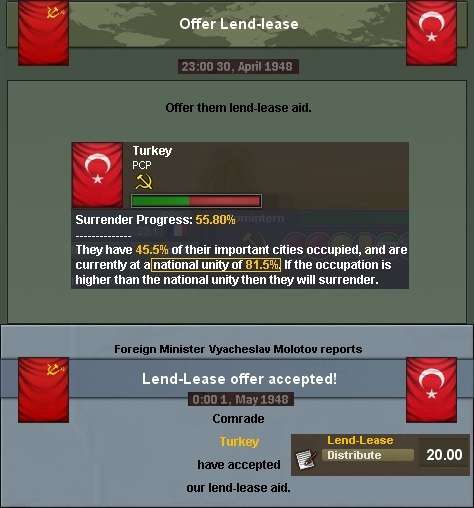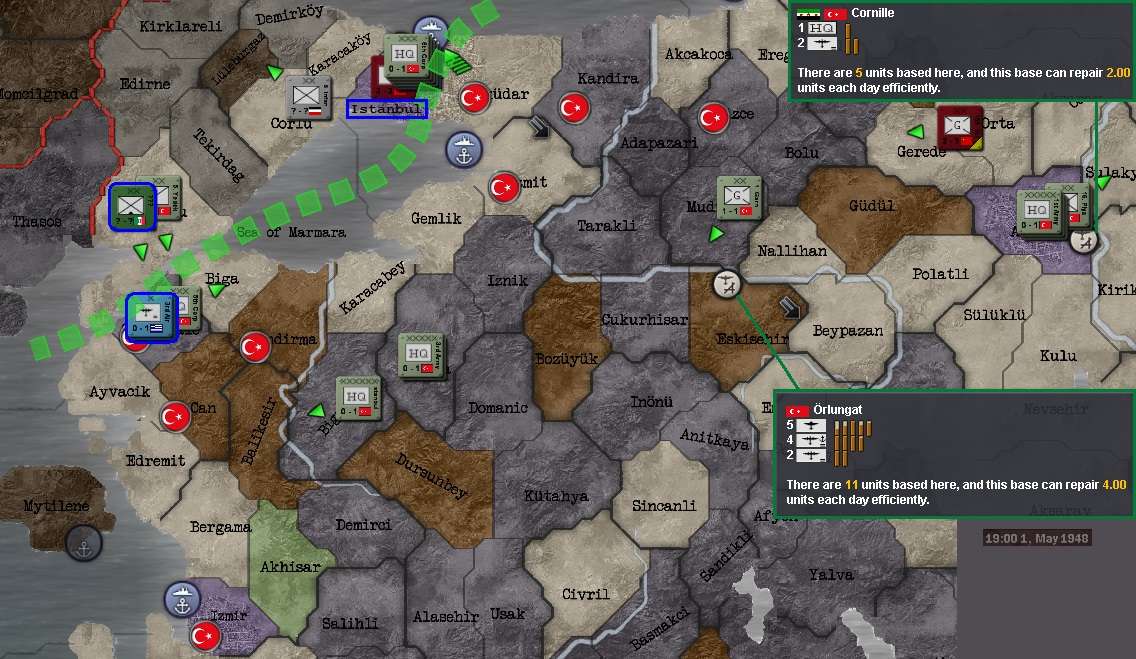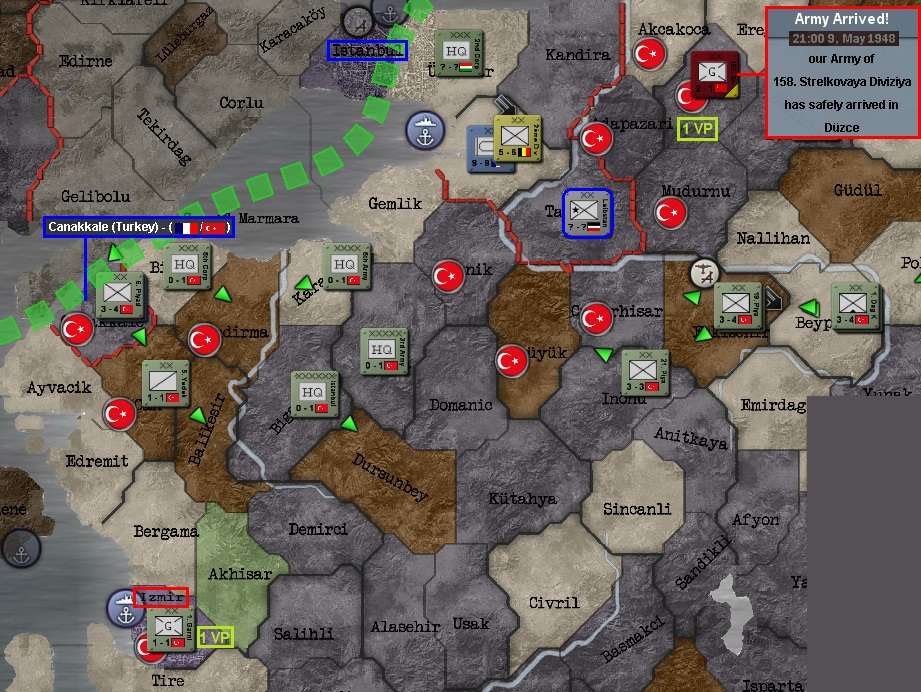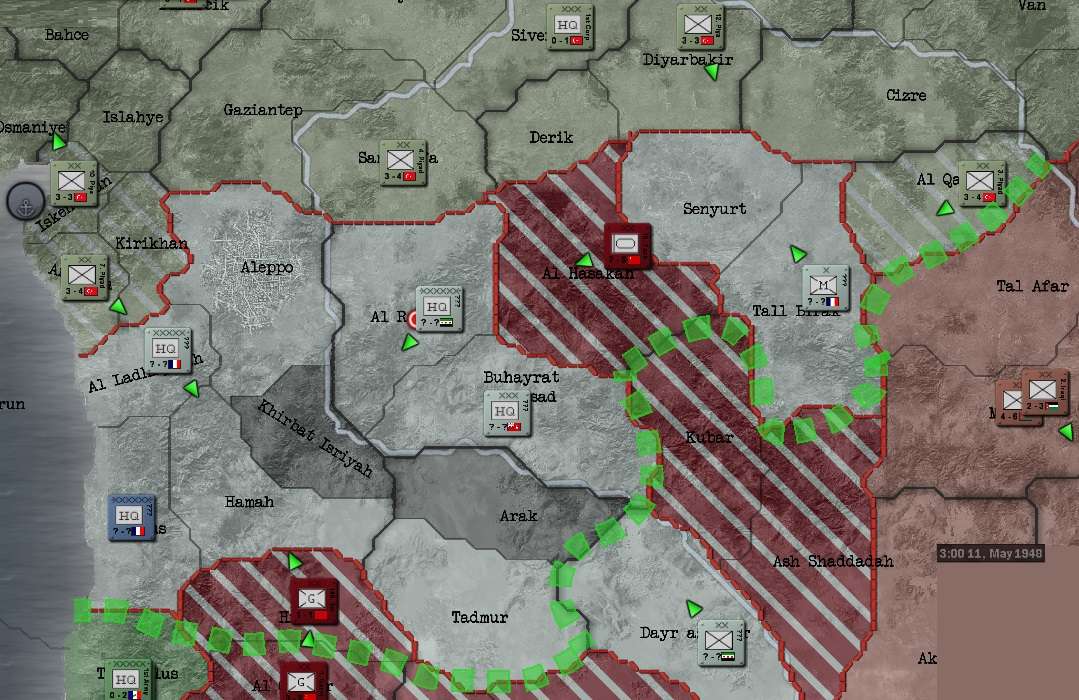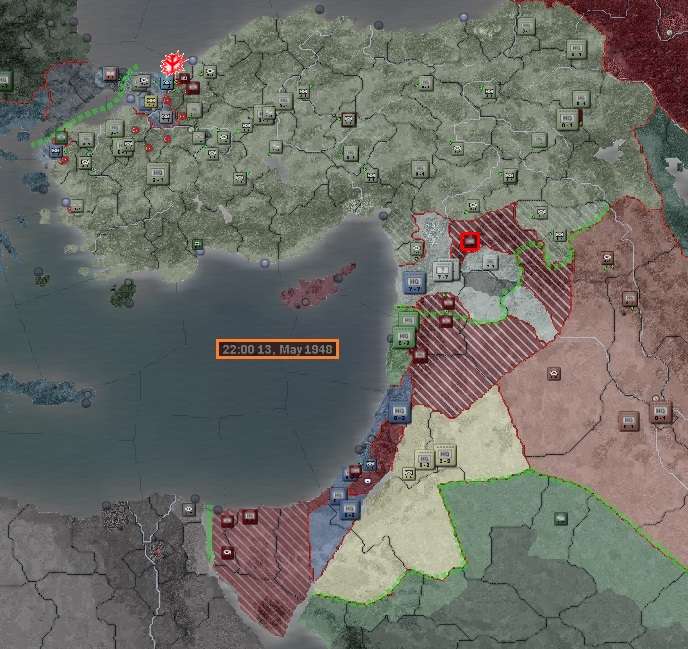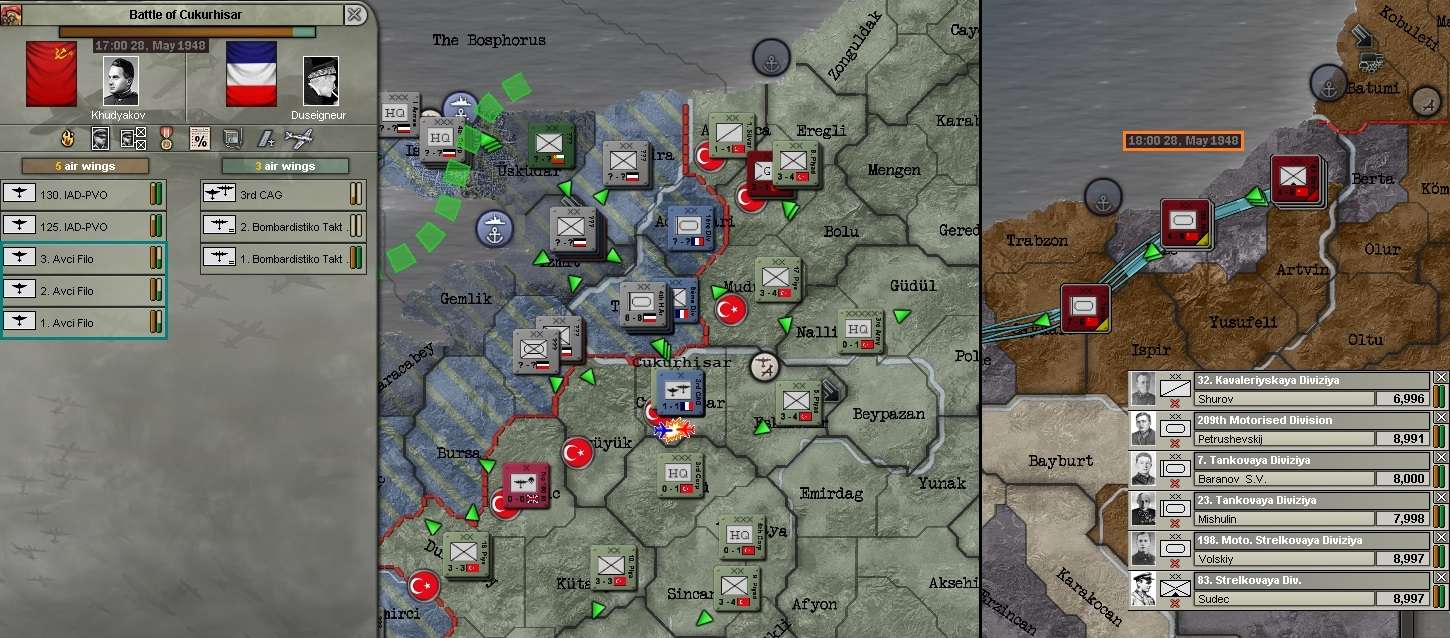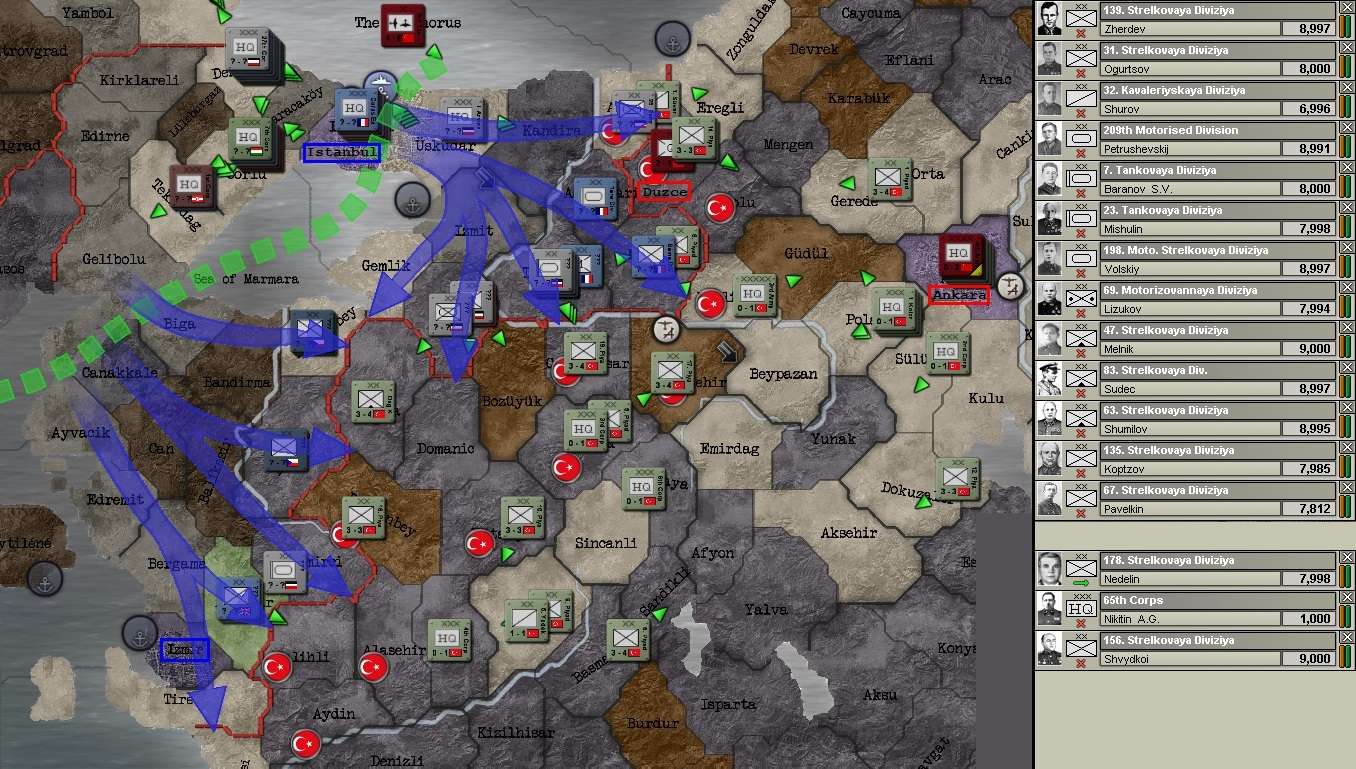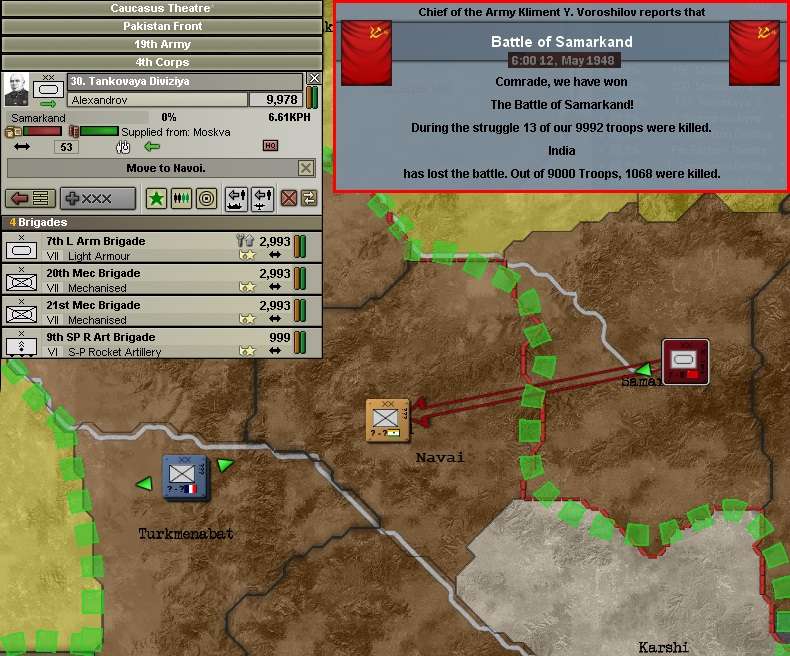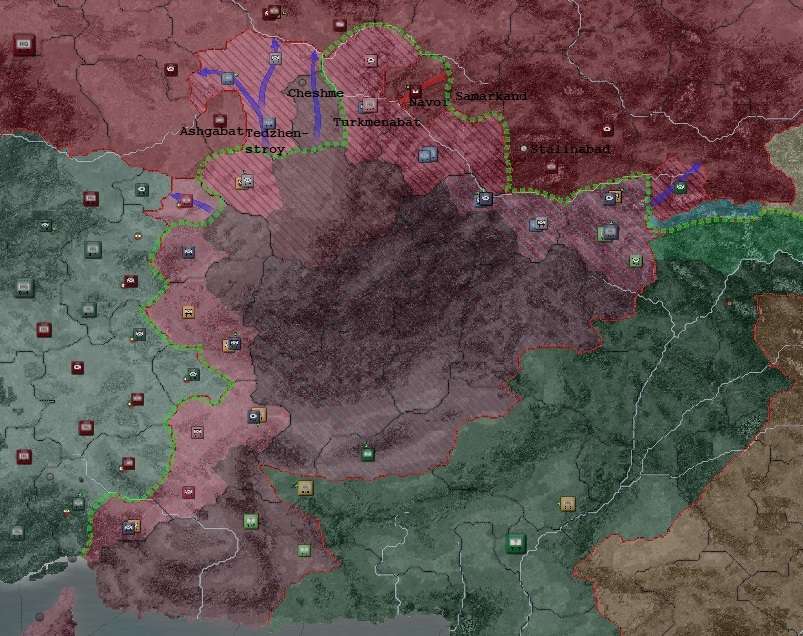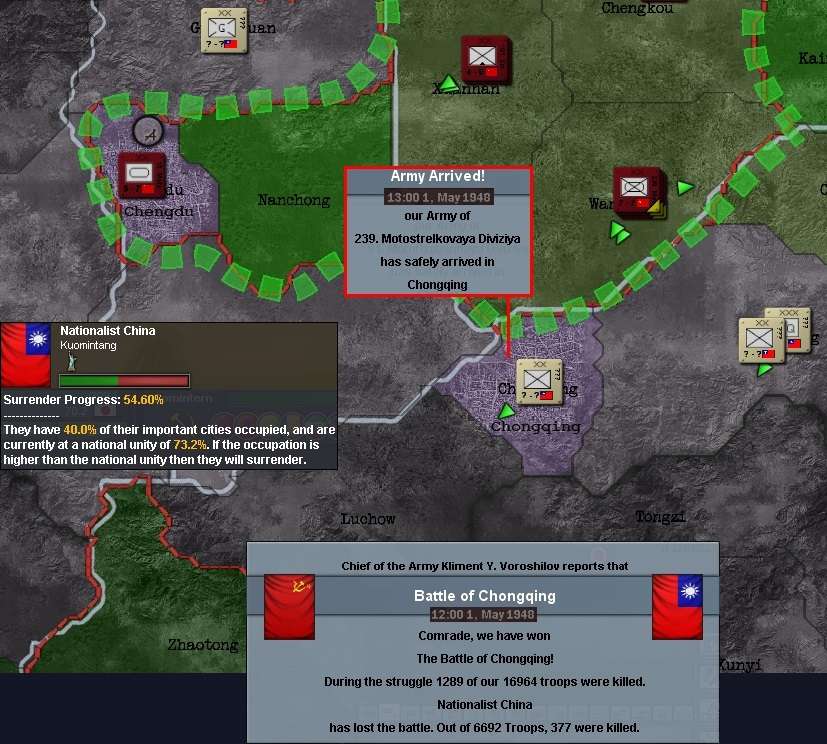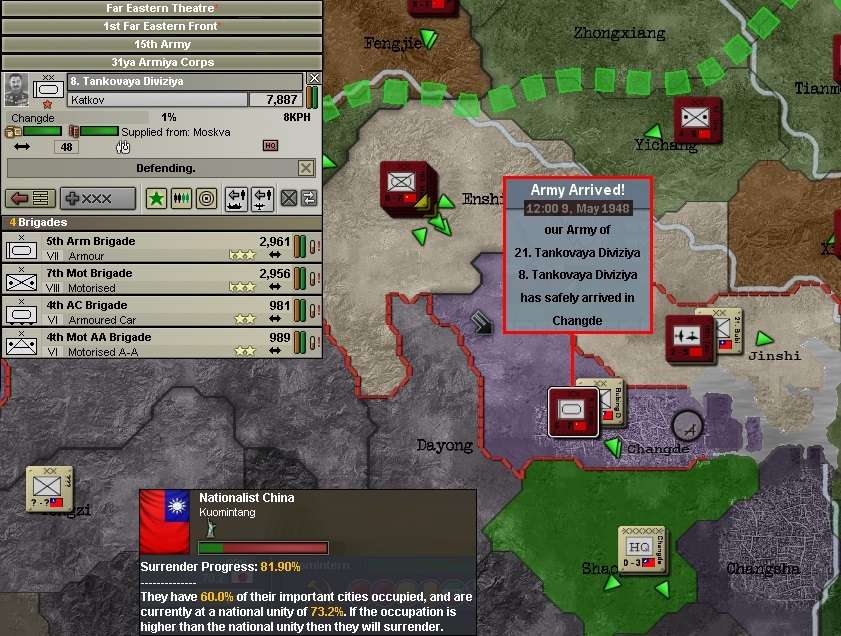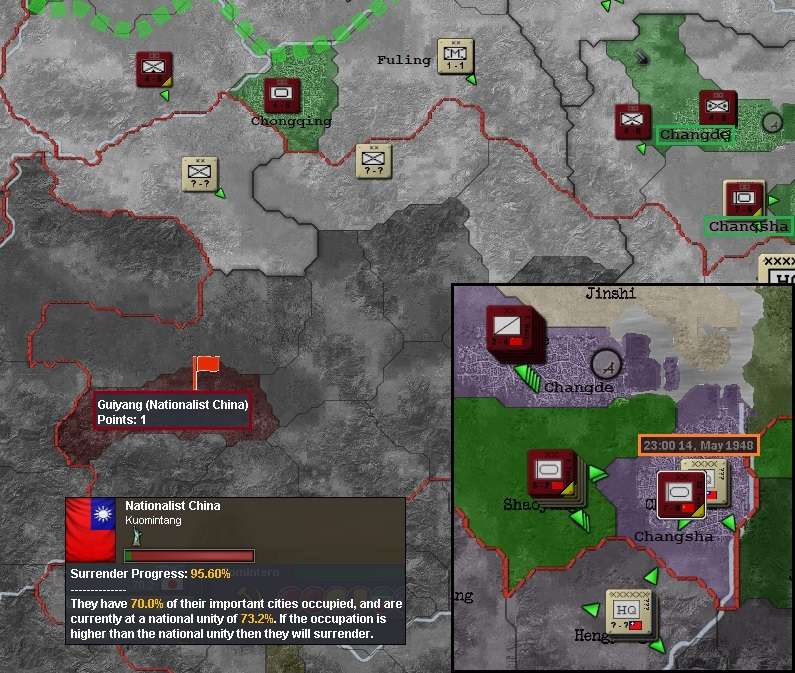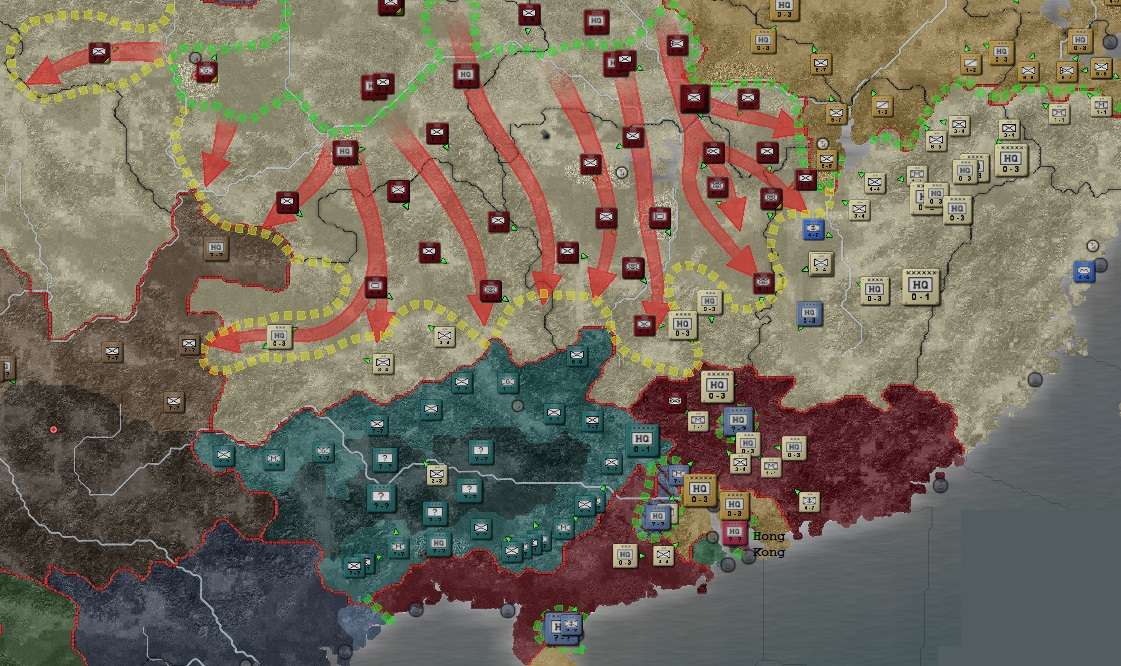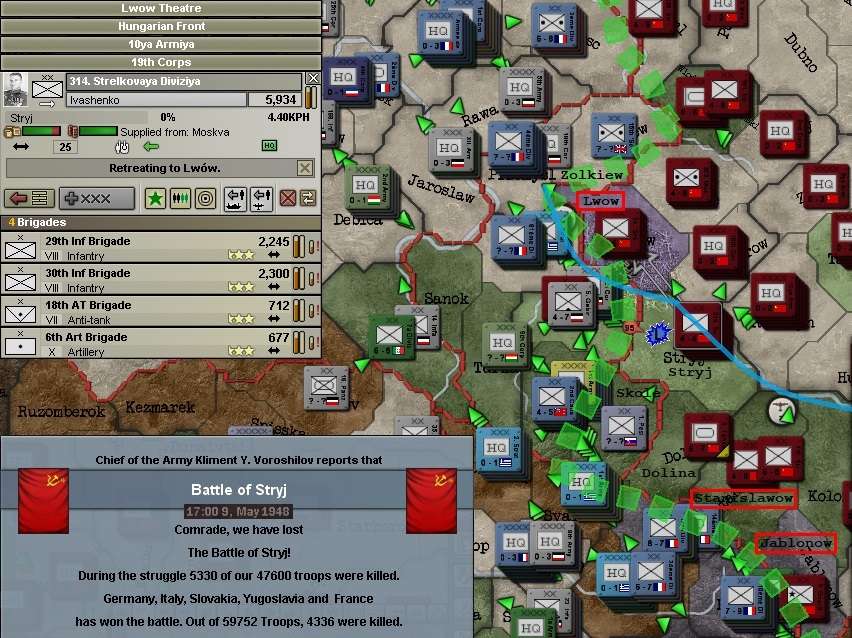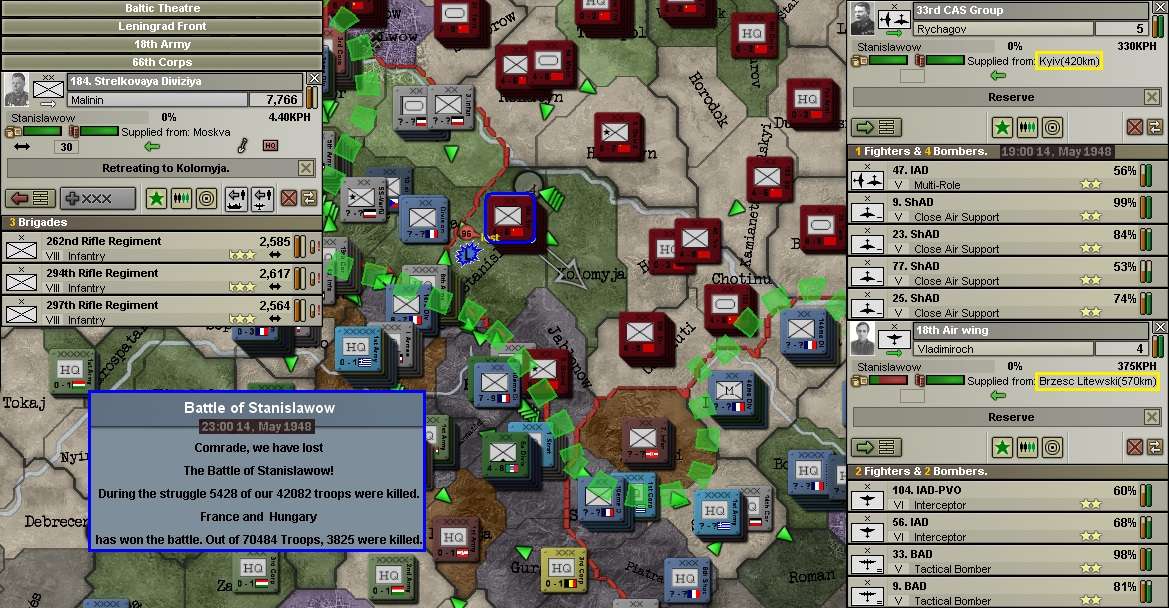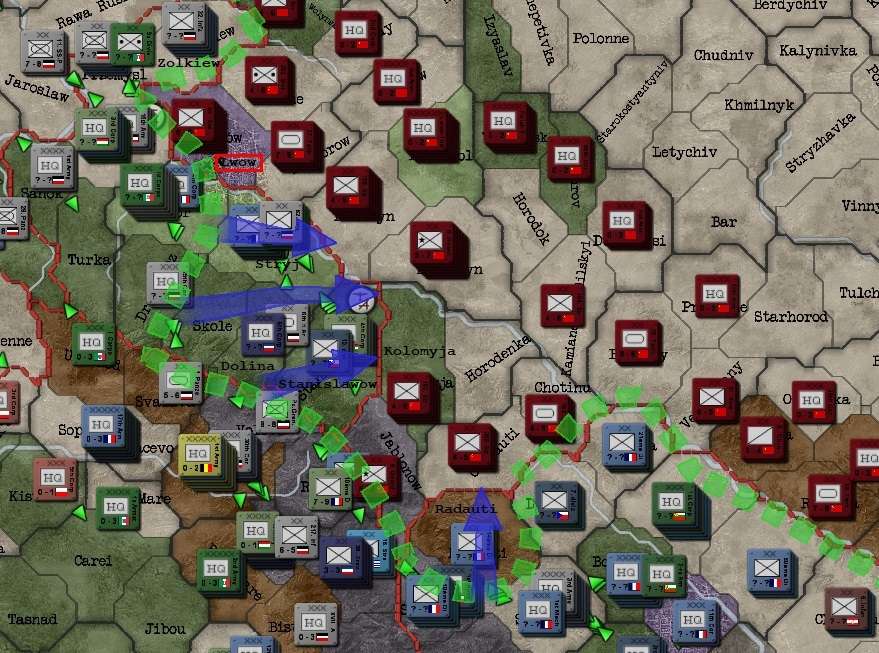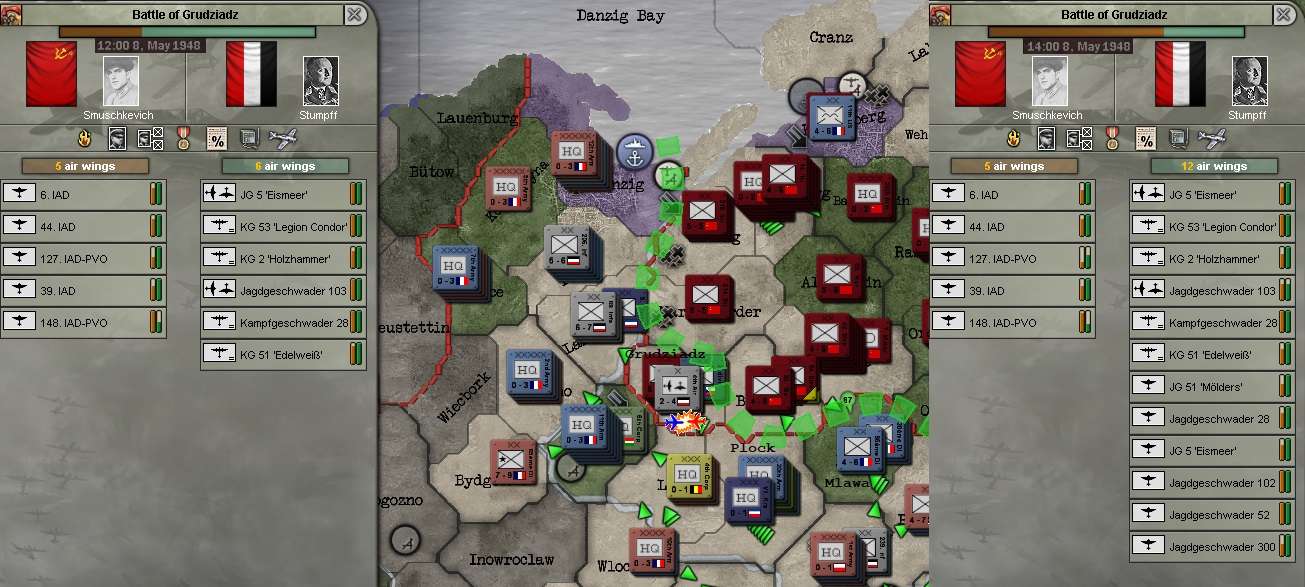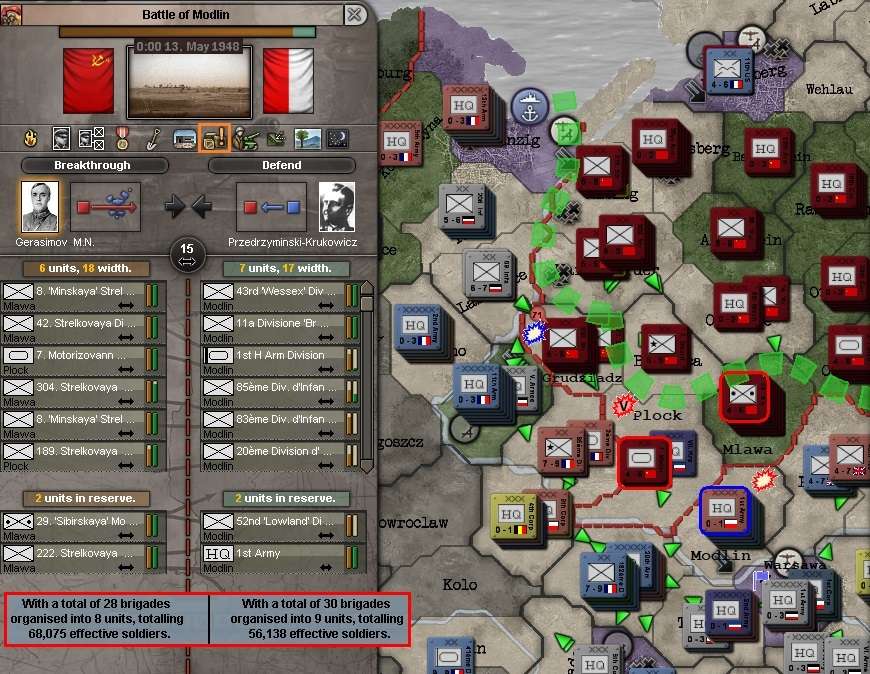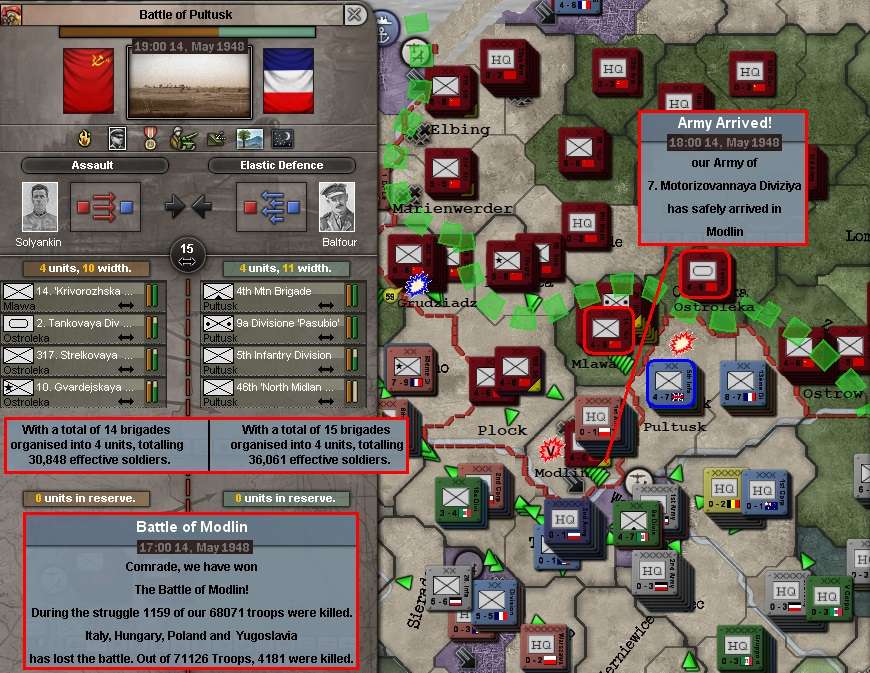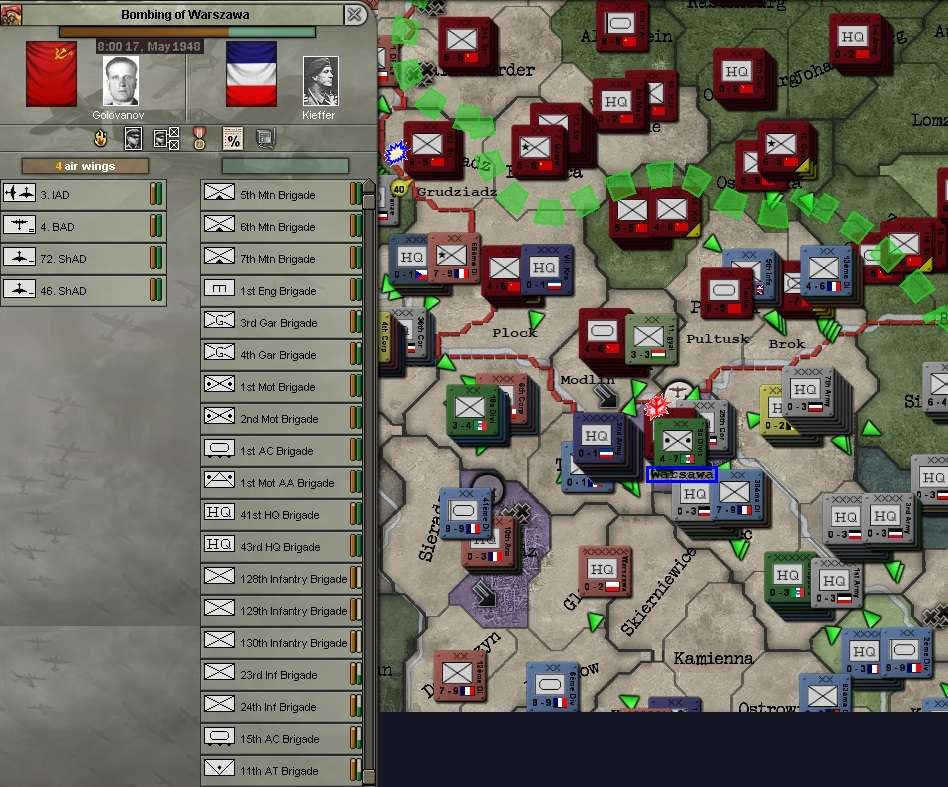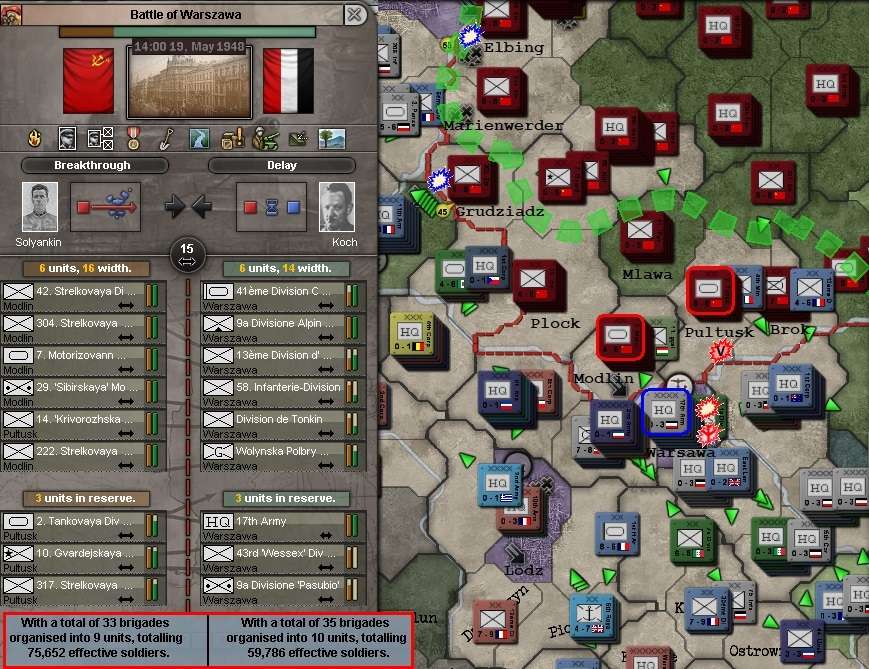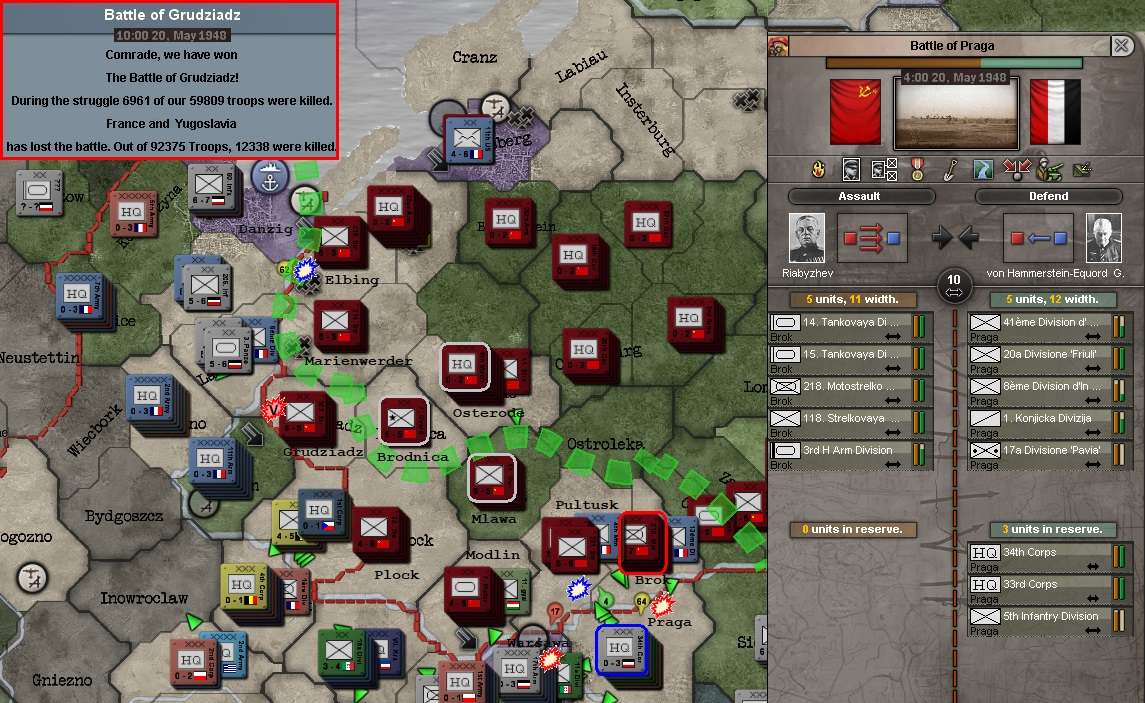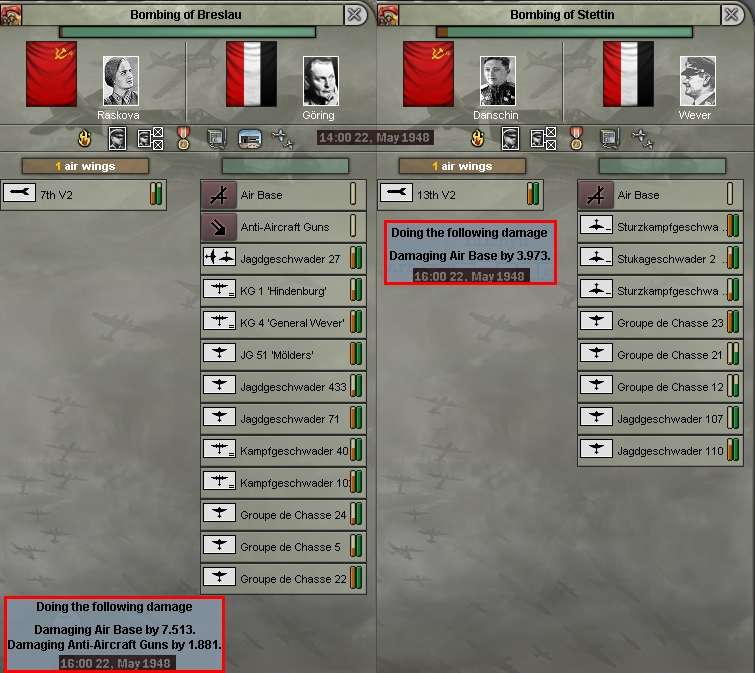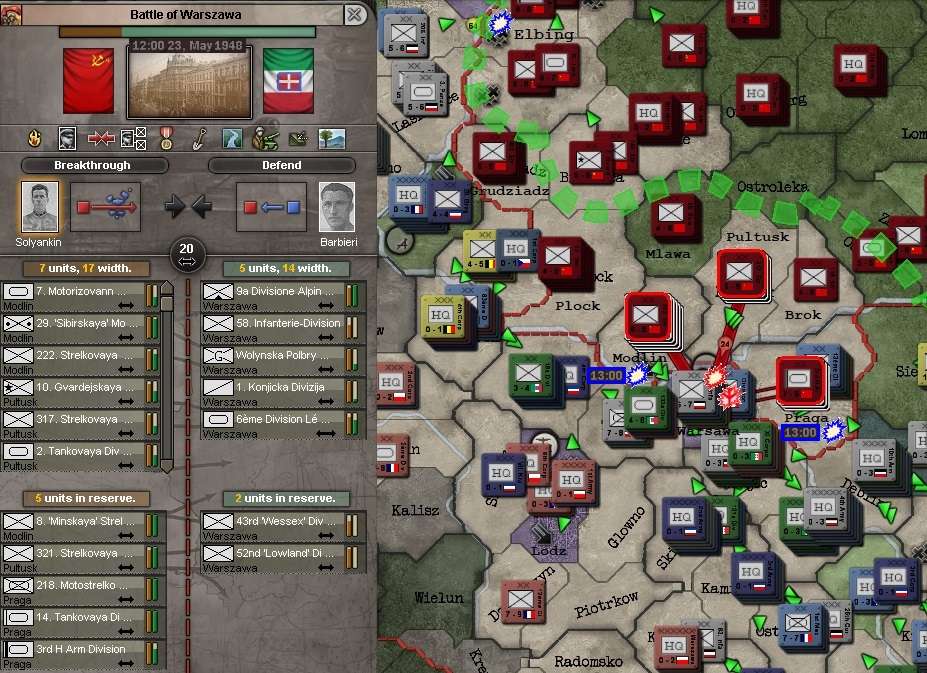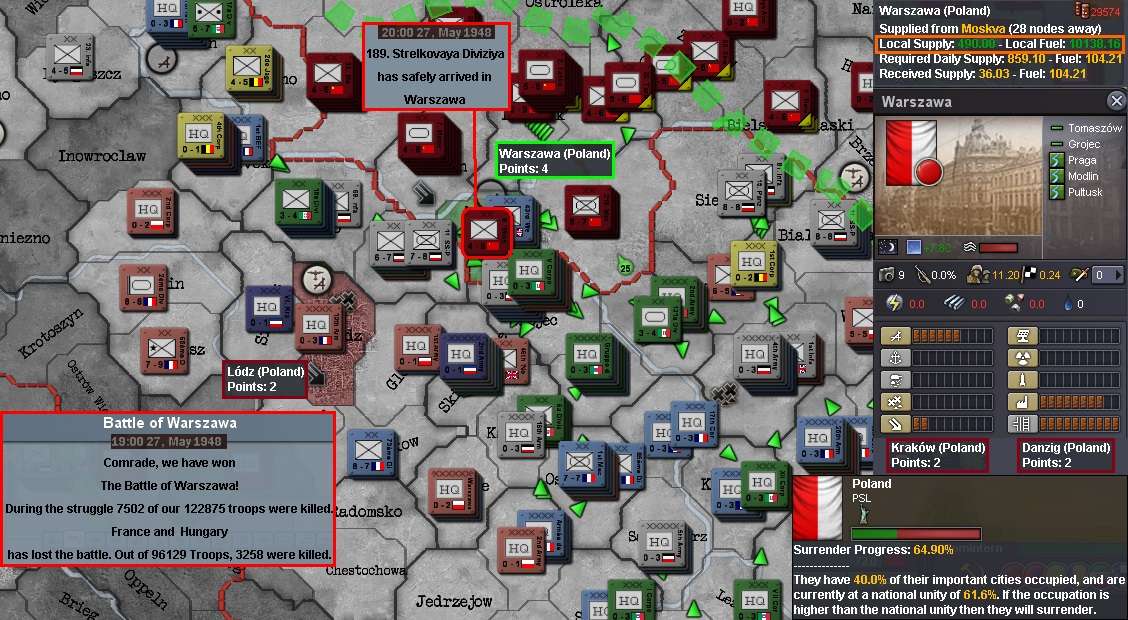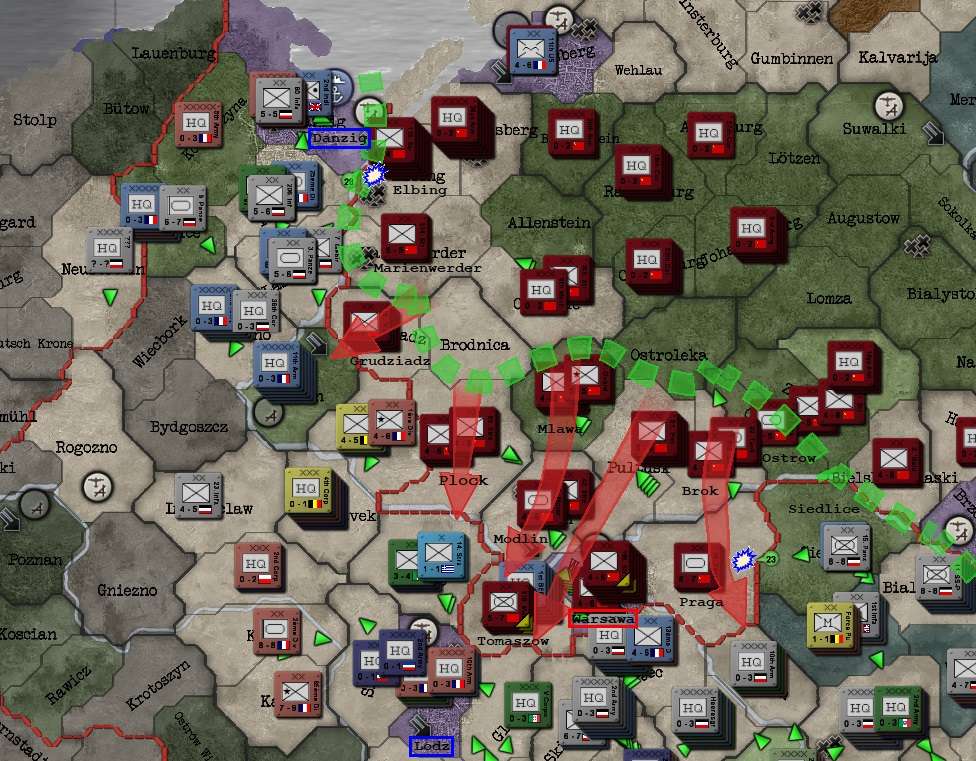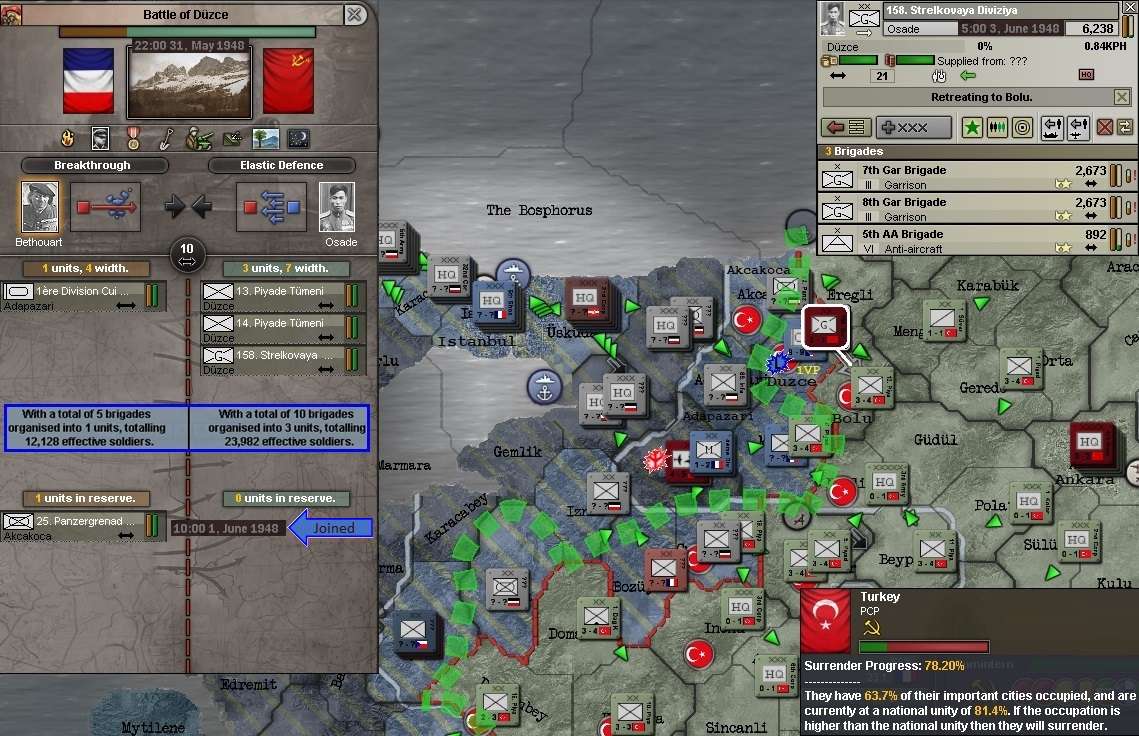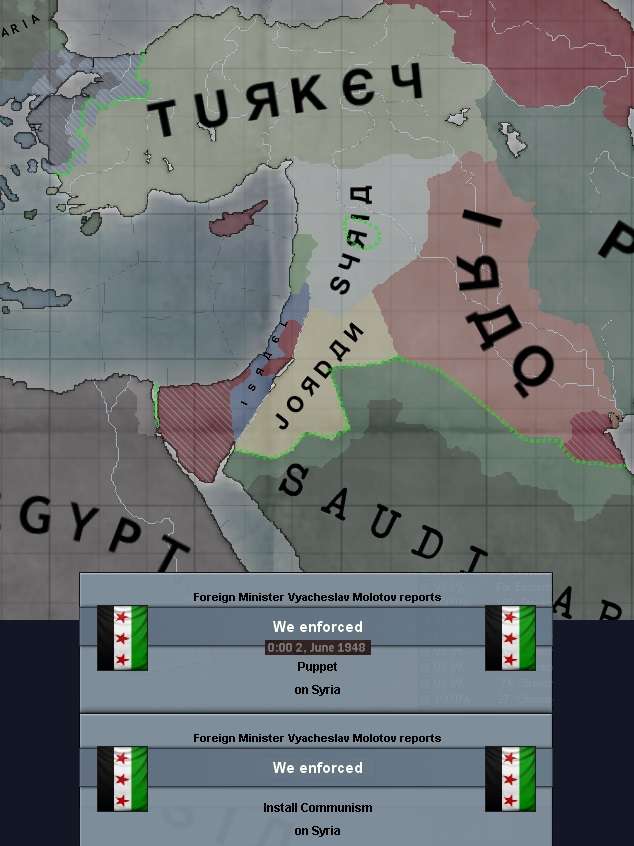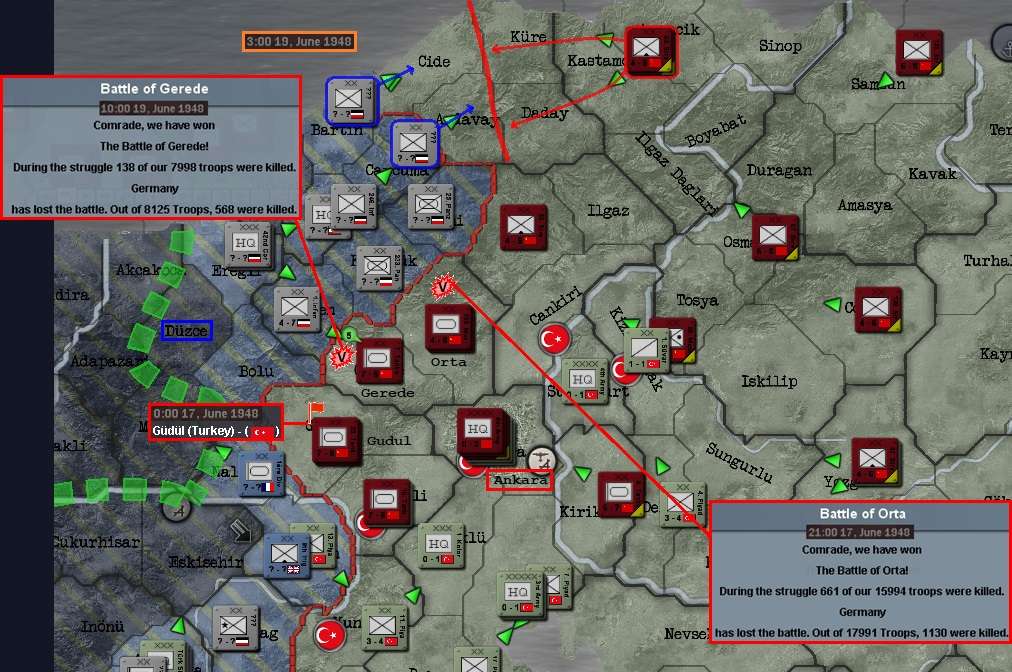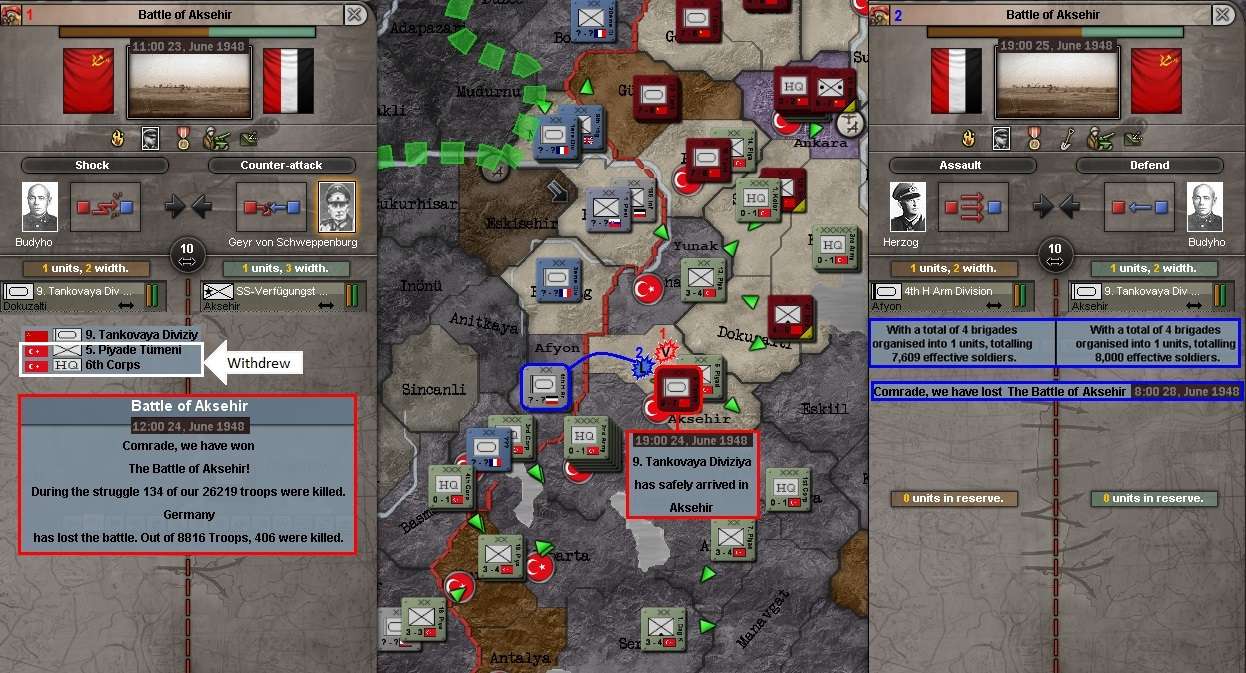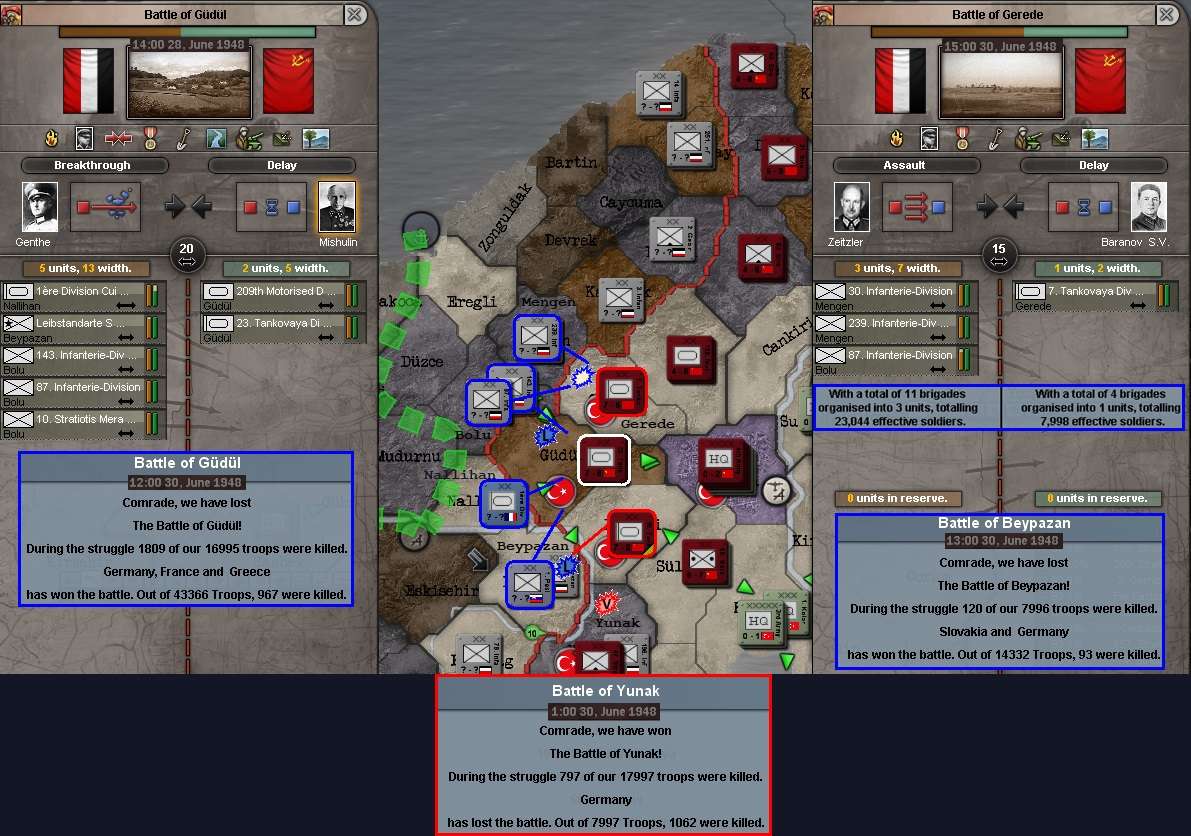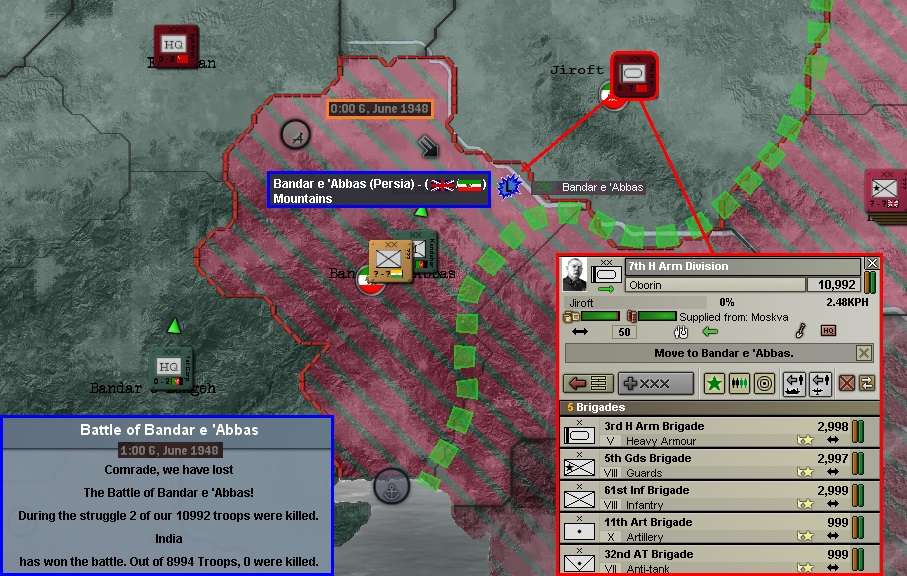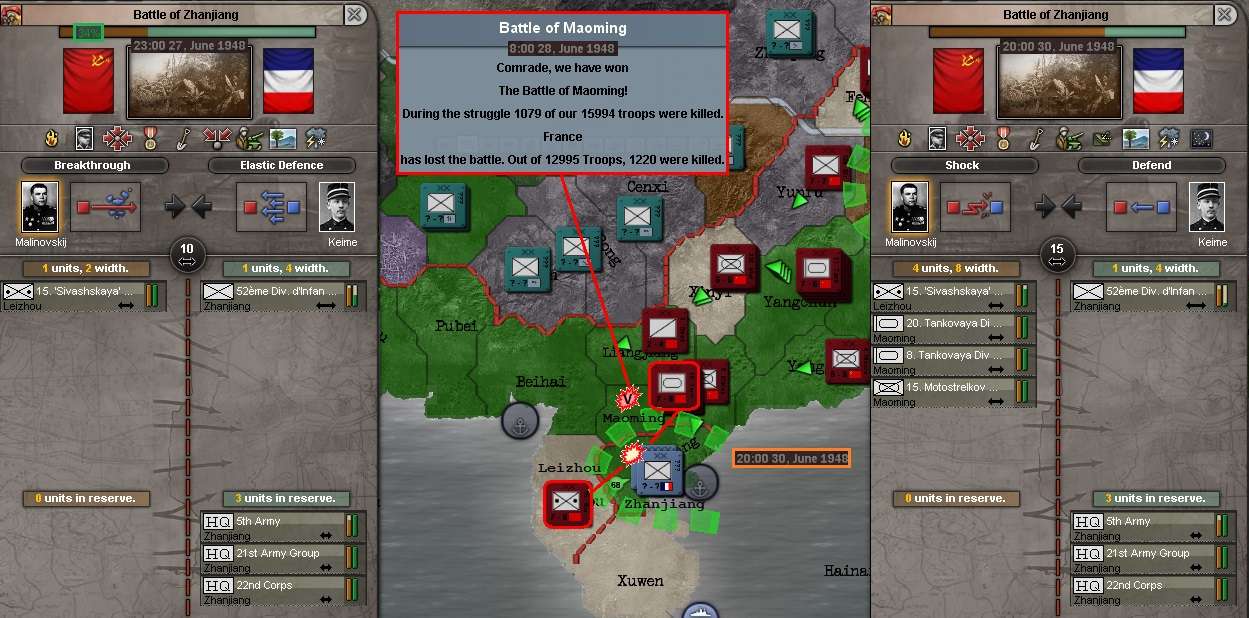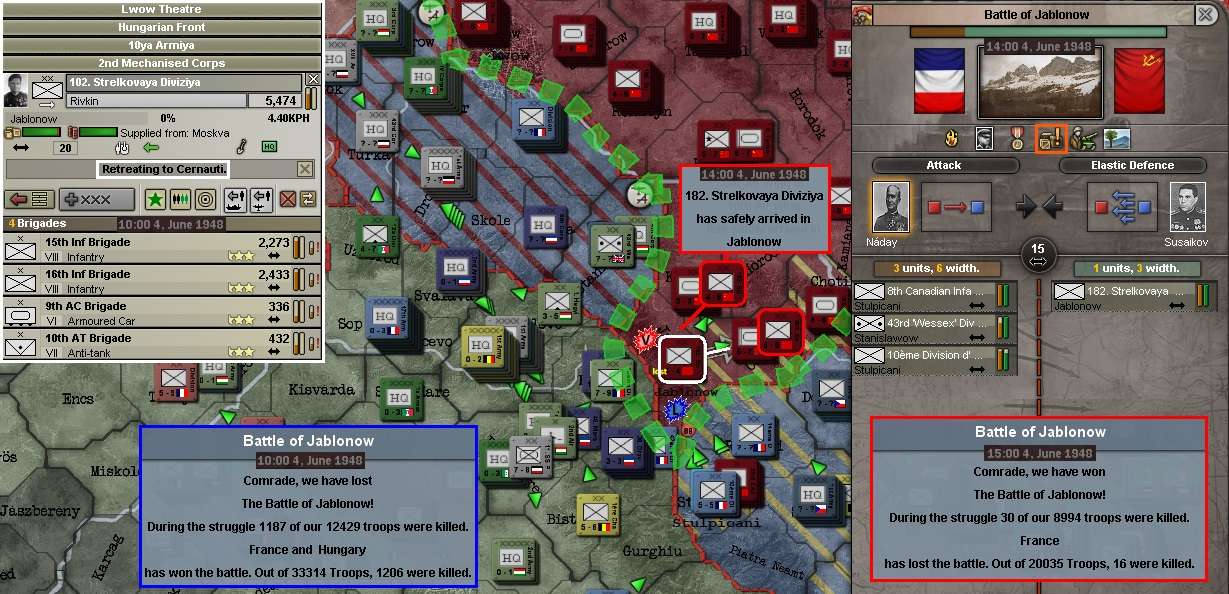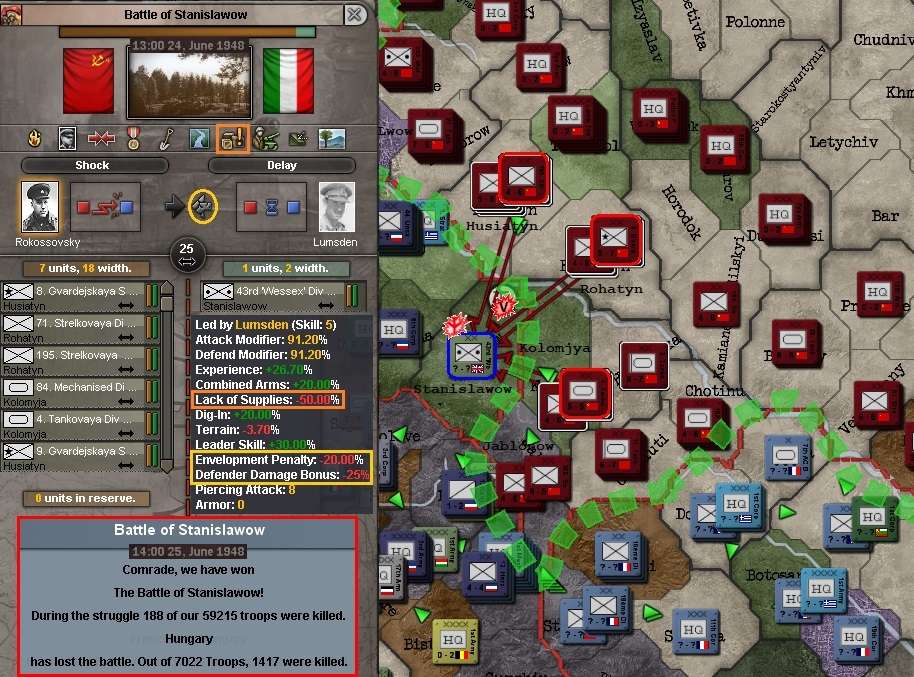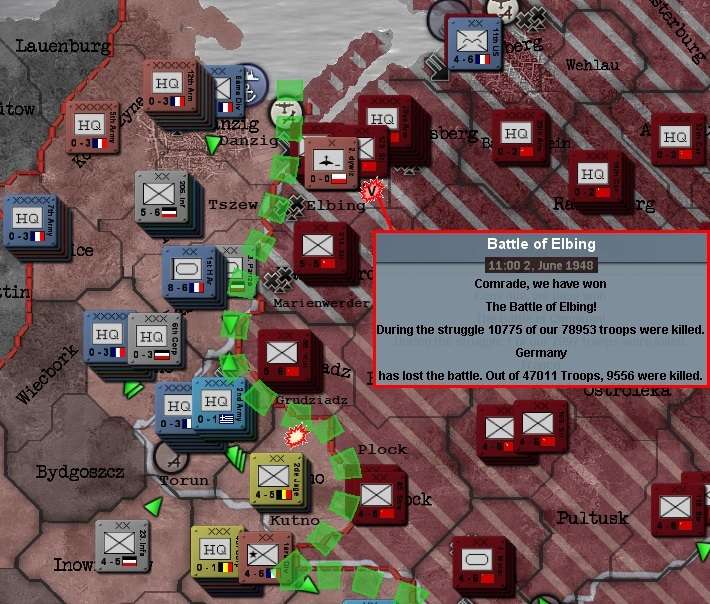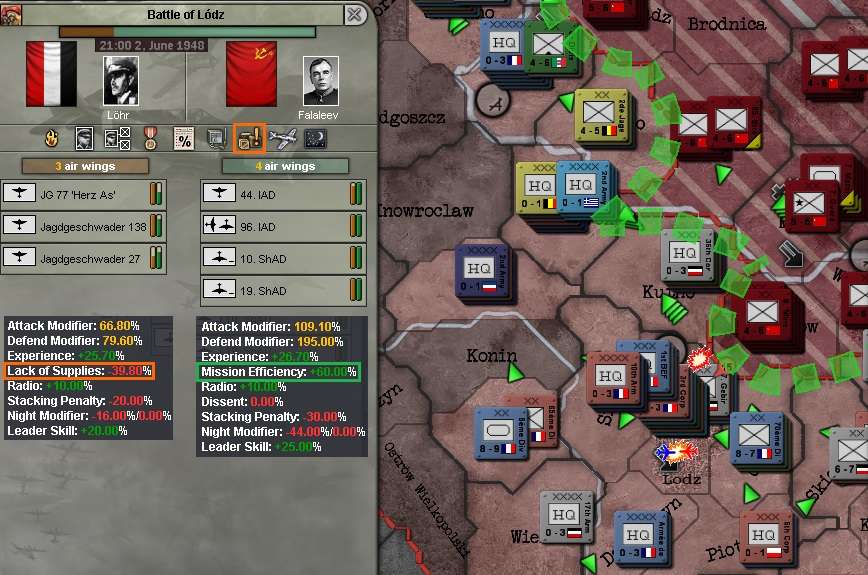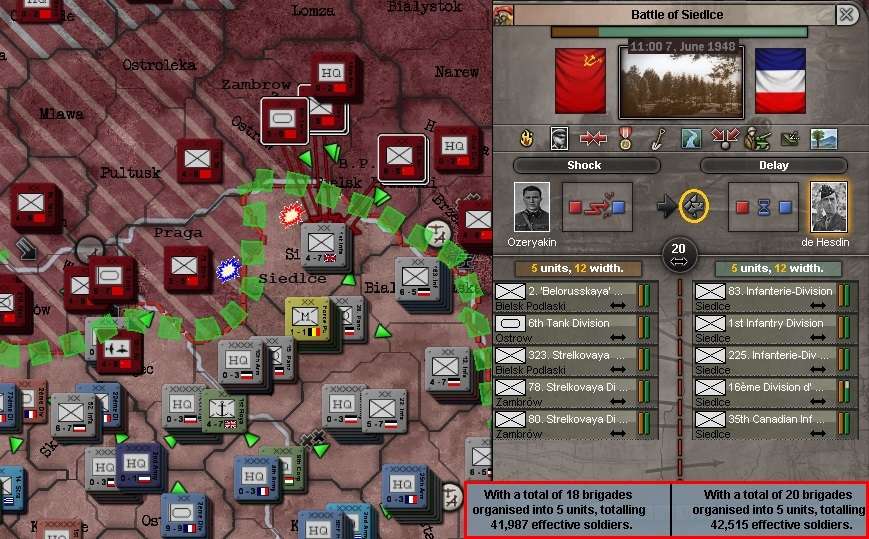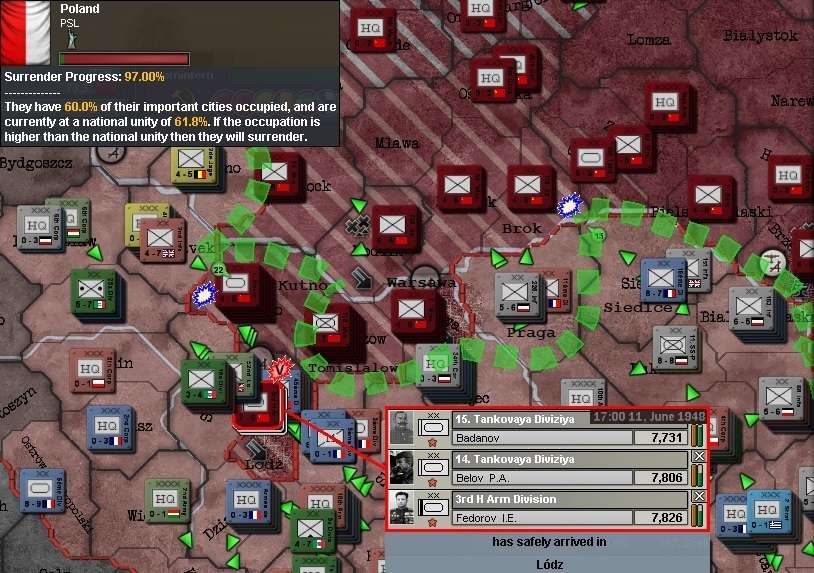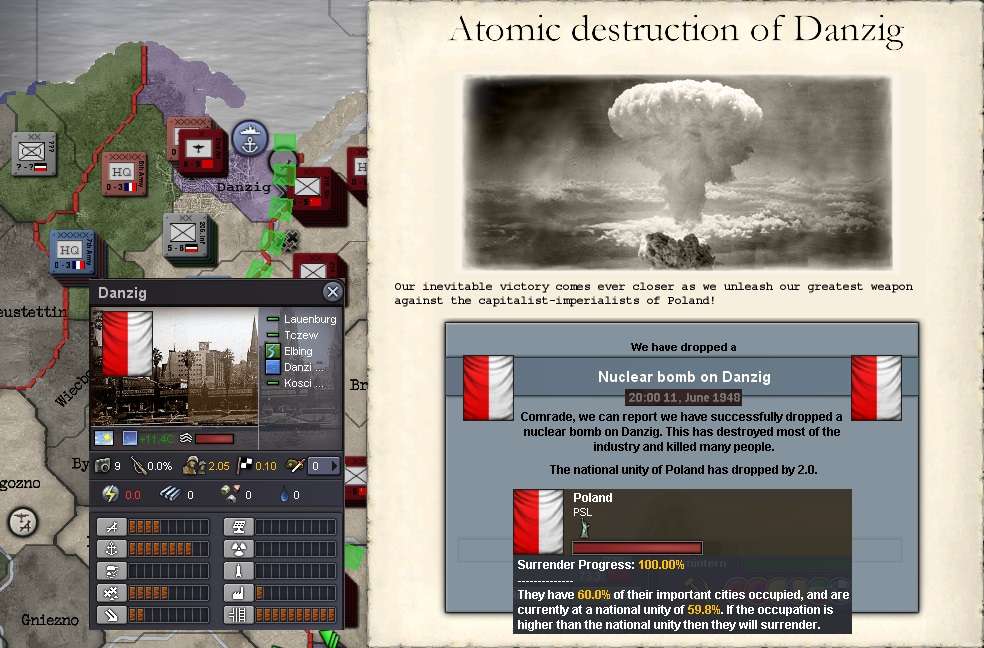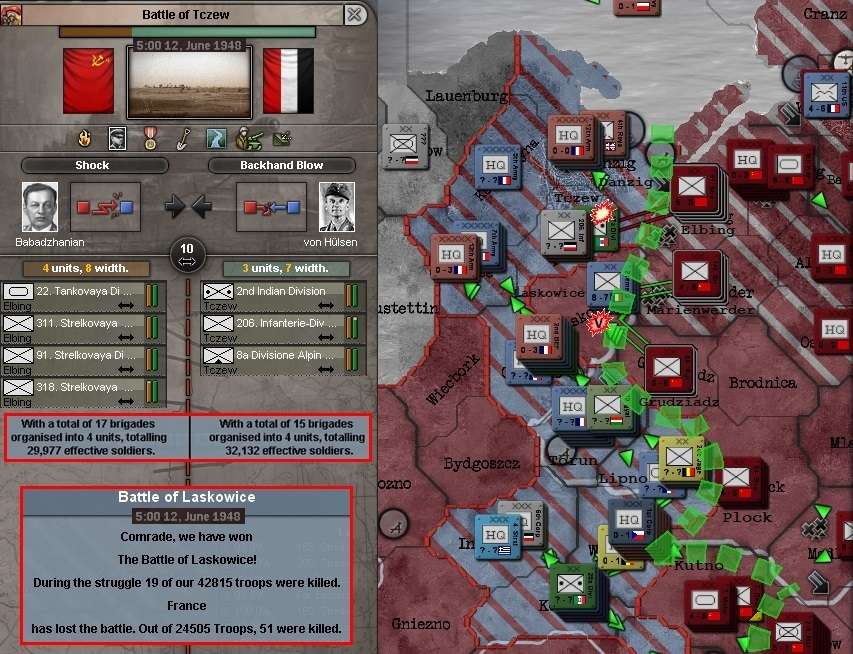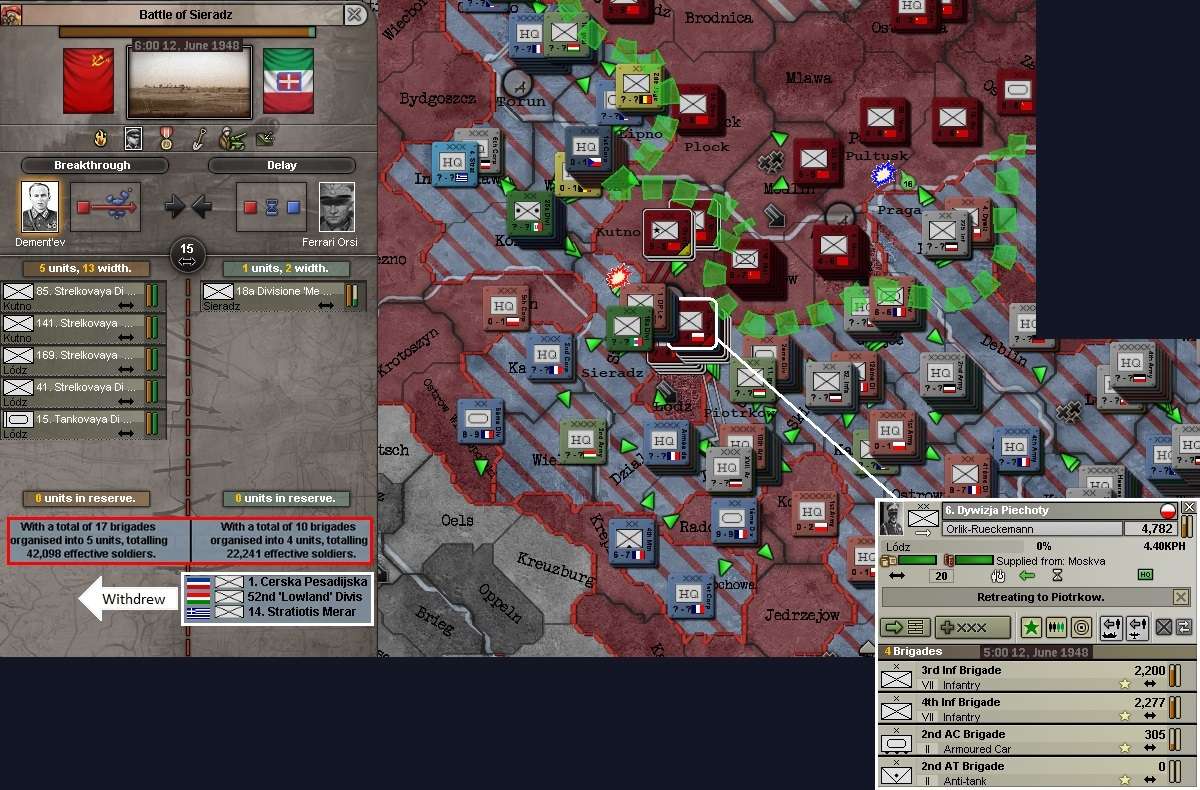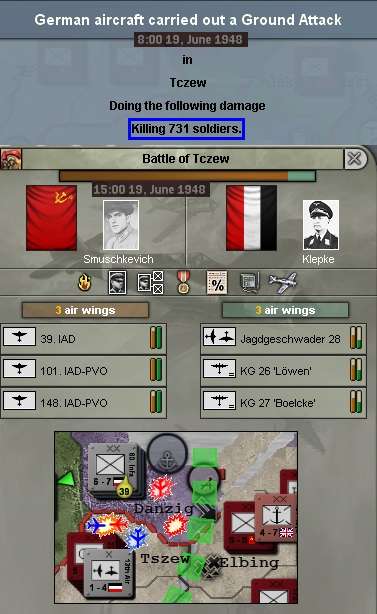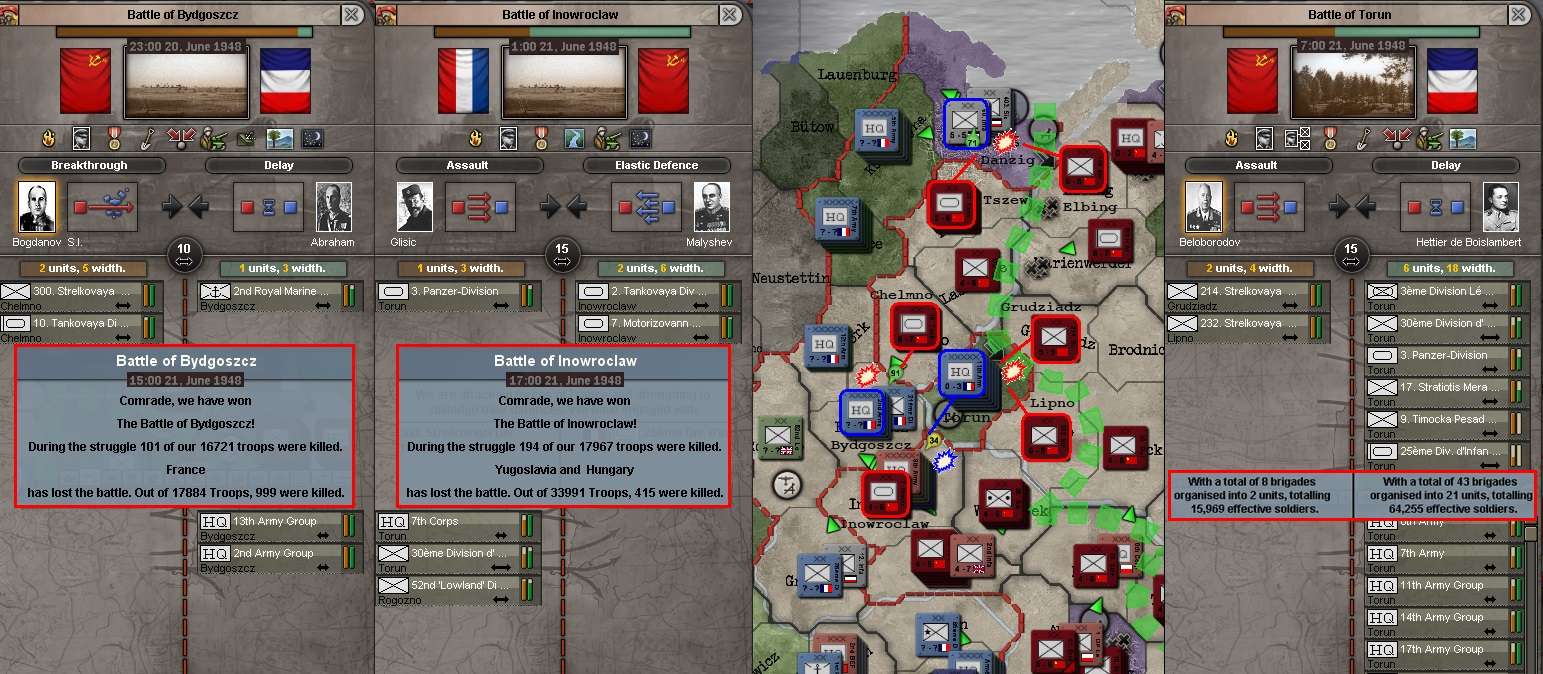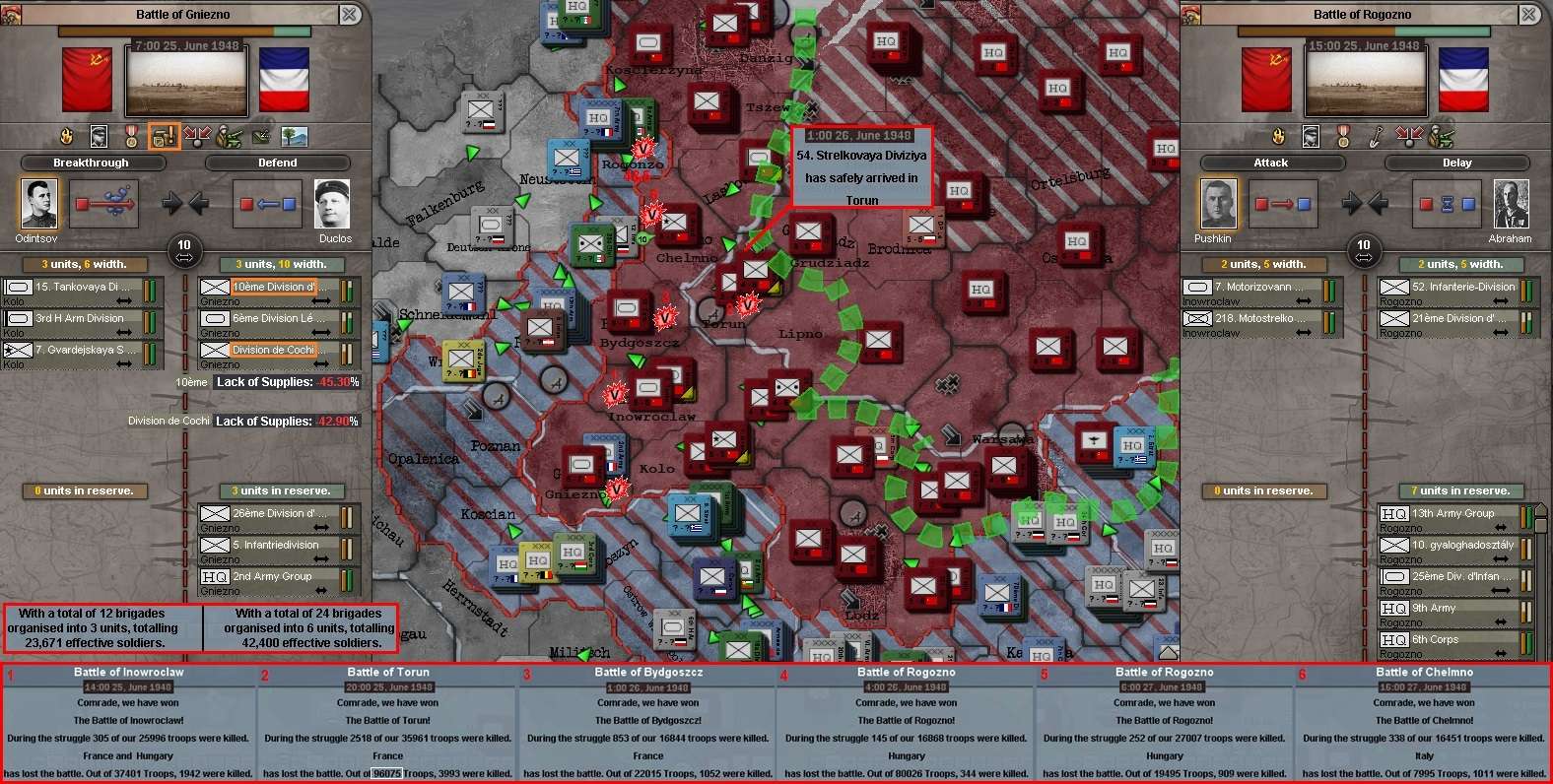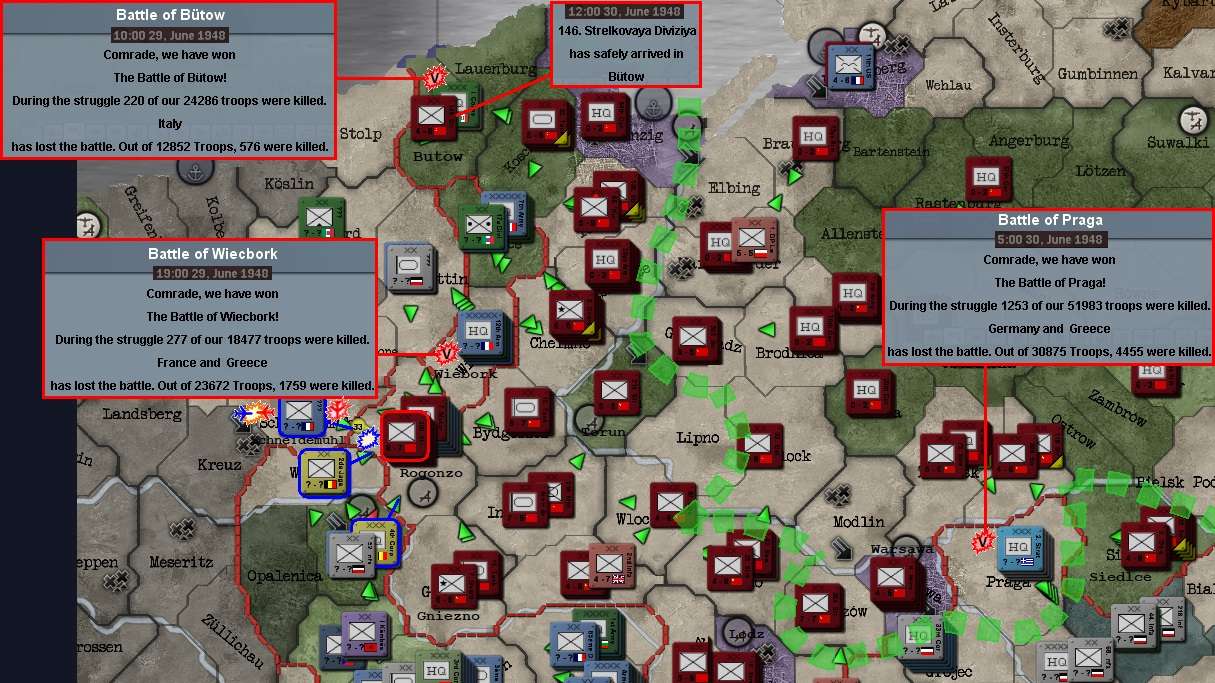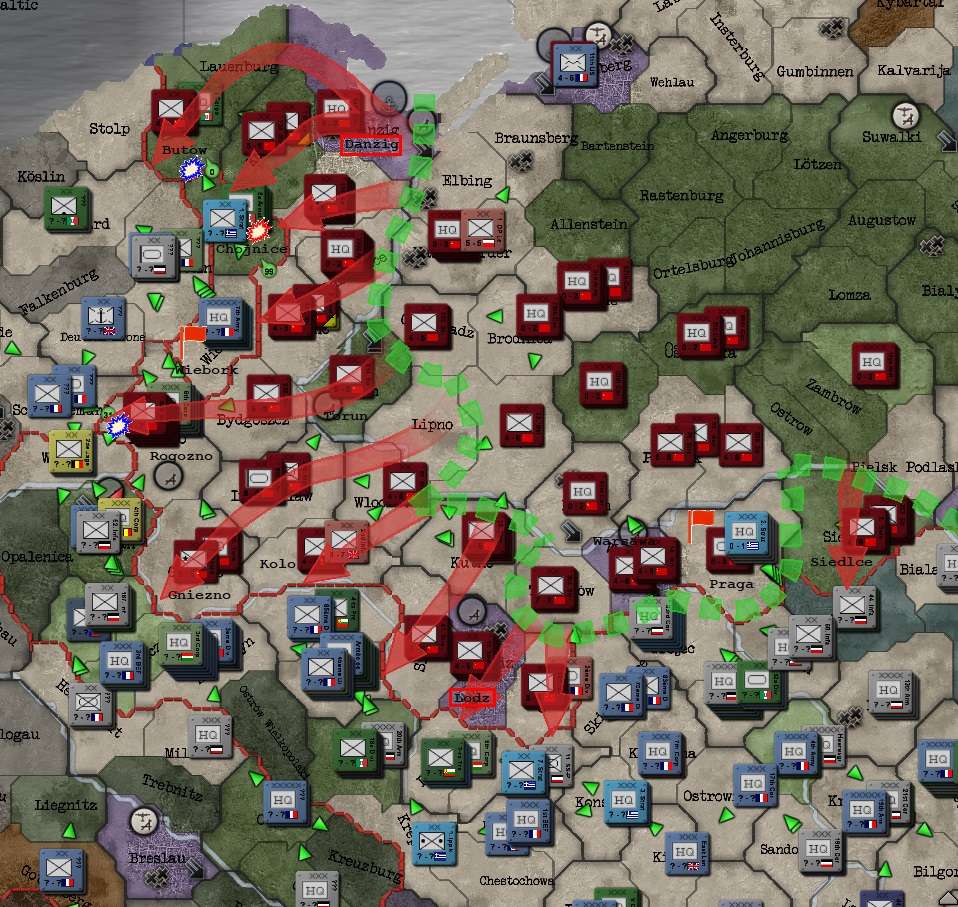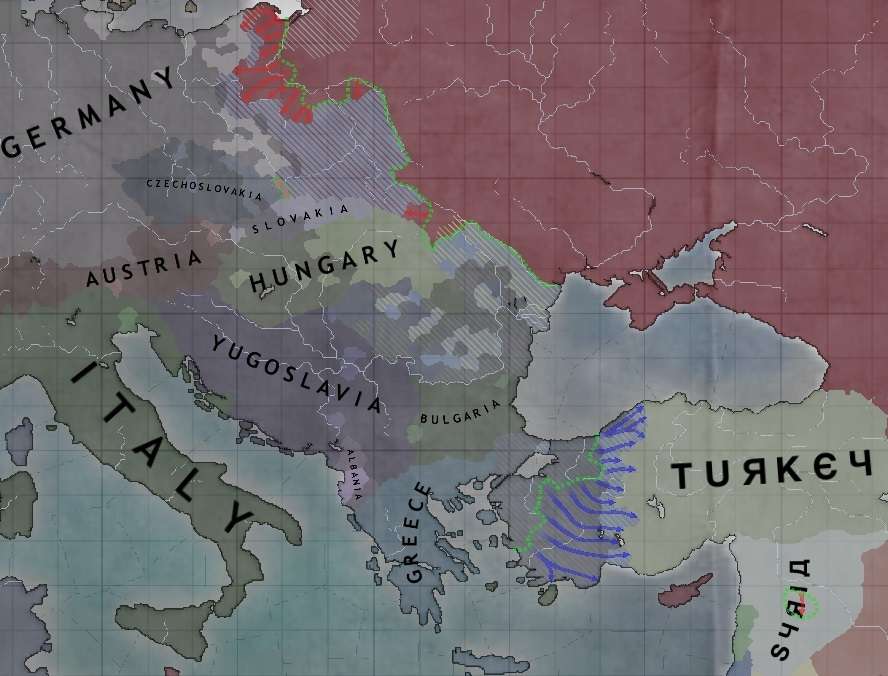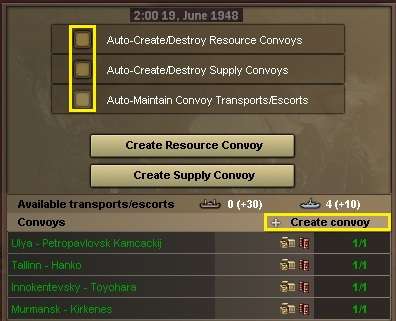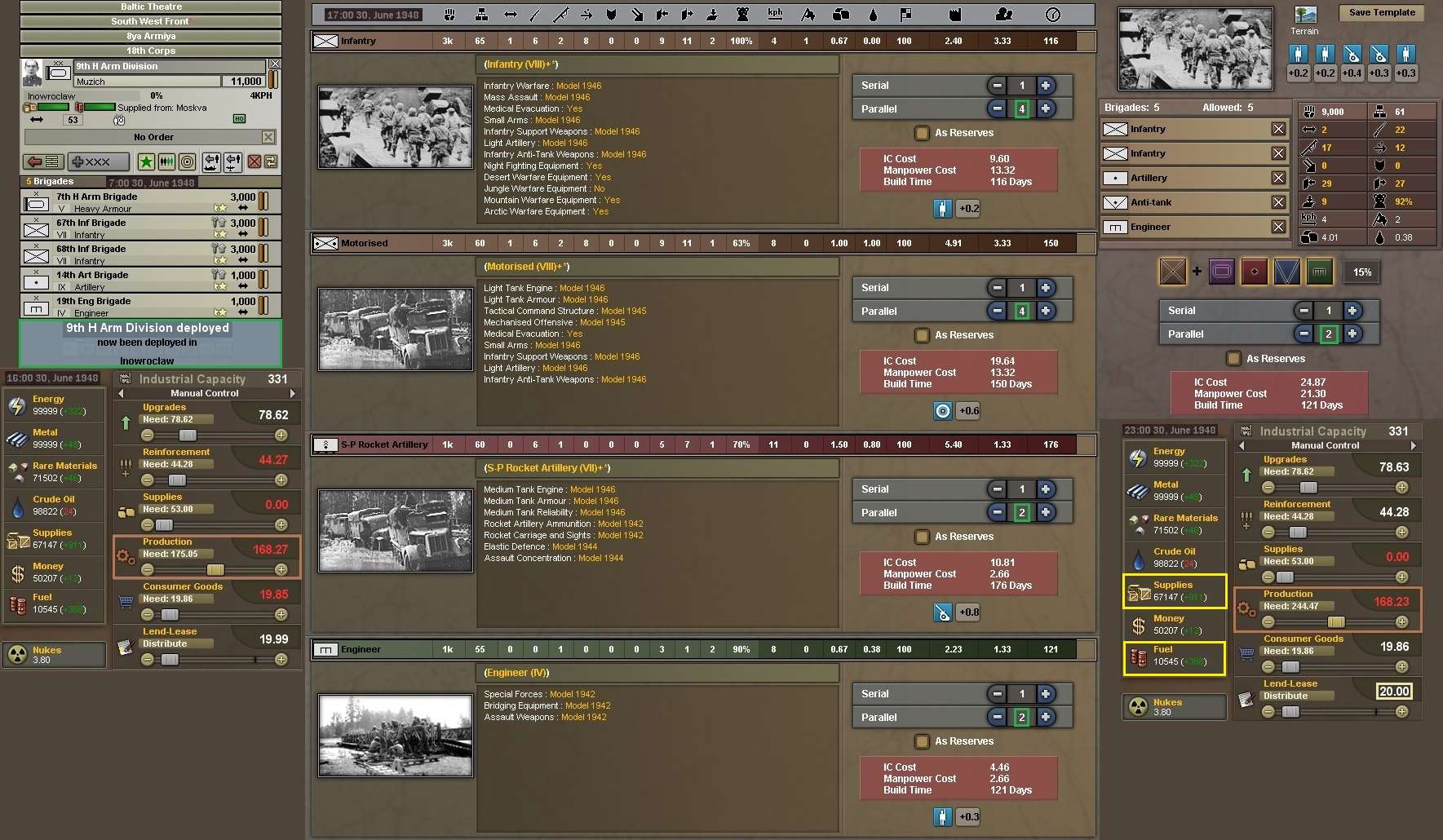Chapter 45: June 1948
Note: This update also covers 31 May, which was omitted from the last chapter … another long chapter, but a whole month of major action on many fronts has been included.
******
1. Turkey and the Middle East
A foolhardy carry-over attack by the Egyptians over the Suez on Români was called off at 1500hr on 31 May (Soviets 78/14,988; Egypt 724/8,999).
The Turks and Soviets (who retreated first, so no report) lost the battle to hold the VP province of Düzce late on 31 May as the Allied breakout spread out into Anatolia.
Tadmur, the last unoccupied province in Syria, was taken at 0100hr on 1 June by 16 Tk Div. They were strategically redeployed immediately to Ankara, along with 9 Tk Div. Syria formally surrendered at the beginning of 2 June, completing the Soviet campaign to take the Middle East and puppet their governments.
The following evening, the Syrians optimistically announced they were mobilising ‘and would soon have a strong army’, but would remain at truce with the Allies for two years.
The first division of the main Soviet redeployment to Turkey arrived in Ankara at 1000hr on 9 June. They were ordered straight to the plains of Gerede and ordered to defend it as Turkish forces fell back in front of them from the Allied onslaught in the mountains around Mengen and Bolu.
But they were not quick enough: The German 1. Infanterie occupied Gerede at 1100hr on 11 June and 7 Tk Div attacked
[52% initial progress], to prevent the Allies gaining access to Ankara. Gerede would be fought over fiercely for the rest of the month. The Soviets would find victory at 0800 on 13 June (Soviets 163/7,998; Germans 432/8,994 killed).
The French took Güdül, south of Gerede and also bordering Ankara, on 13 June. By then, 209 MRD had arrived in Ankara. They counter-attacked the first-line 1ère Cuirassiers at 1200hr, but broke off straight away when the fight proved too one-sided (Soviets 31/8,991; France 0/10,620 killed).
A more deliberate Soviet attack on the 1ère Cuirassiers in Güdül was soon prepared by 209 MRD (Ankara) and 23 Tk Div (recently arrived to the south in Polati), which went in at 0300hr on 14 June. Victory was won after two and a half days of hard fighting at 1800hr on 16 June (Soviets 1,232/24,998; France 899/10,863 killed).
A serious Allied attack had gone in north-east of Gerede on a recently arrived Soviet motor rifle division in Orta
[-61% progress] on the morning of 14 June. 7 Tk Div had won in Gerede and retaken it by 0700 on the 14th, but was still reorganising so could not yet spoil the attack on Orta by hitting Karabük, but the VVS TAC group in Sevastopol pounded away at the enemy attackers there day and night.
By the evening of 16 June, the southern half of the front, which was entirely manned by the Turks, was steadily retreating through the mountains of southern Anatolia, falling back towards Antalya on the southern coast, like a door swinging shut on the pivot point of the southernmost Soviet division holding just south of Ankara.
In the north, by the morning of 17 June, the Soviet line was beginning to solidify, building from the south in Gerede up to the Black Sea coast north of Ankara around Küre and Daday to the south of that. It was a race as German infantry and panzer-grenadiers closed on the same places from the south-west.
The Soviets retook Güdül at midnight on 17 June after their earlier victory. The battle for the defence of Orta was won on the night of the 17th after another Soviet division arrived to reinforce. And 7 Tk Div defeated a German attempt to retake Gerede by 1000hr on 19 June. The race to shore up the northern part of the line, a little reminiscent of the ‘Race to the Sea’ in Belgium in August 1914, was drawing to its final stages.
By 1700hr that evening, the two Soviet divisions had reached the mountains of Küre and Daday and began digging in as the Germans closed up to the front of them. As that was happening, a group of three (partly worn out) Luftwaffe INT wings made their first recent intervention against the VVS bomber group based in Sevastopol, over Bolu.
After something of a lull in the Soviet-run sector over the next few days, a Soviet attack was put in on the morning of 23 June to close a gap in the line that had be created by an SS division in Aksehir after the earlier defeat of its Turkish defenders. It was retaken on the evening of the 24th, only for German heavy panzers to counter-attack the following evening. 9 Tk Div would fight hard, but ultimately be forced to retreat by the morning of 28 June (no battle report).
Meanwhile, the Germans had attacked Orta again, but that too was defeated by 1100hr on 25 June (Soviets 880/23,992; Germans 2,132/8,926 killed).
The Turks were defeated in the mountains of Yunak on 27 June and the Soviets decided the location should not be surrendered, as it was the anchor point between them and the Turkish sector in the south. A counter-attack was put in by 47 Mtn Div and 139 SD at 1500hr that afternoon against the German 196. Infanterie.
But as the battle for Yunak was being fought (and eventually won by early on 30 June), the Allies were beginning to reassert the pressure against Güdül and Gerede in the centre, west of Ankara. The fight for Güdül would be lost by 1200hr on the 30th, with a Soviet spoiling attack on Beypazan (begun on the evening of 29 June) called off an hour later. The battle by 7 Tk Div to hold Gerede was still in progress as the month was ending.
Yunak was attacked again by the Allies on the 30th, with fighting there and in Gerede continuing as the day ended, with the situation in the latter starting to deteriorate for 7 Tk Div. In the south, the Turks were now falling back on Alanya, as the line shortened. Just in case, a Soviet garrison division had been stationed back east in Adana since earlier in the month, after the surrender of Syria.
A large portion of the German Army and a number of French units were now committed to this front, which was causing the Turks in particular problems, but it had also sucked in the Allies to stripping many units away from the main Western Front, where the Soviet hammer was striking again.
******
2. Central Asia
An initial radar station was completed in Stalinabad on 4 June and the next level commenced immediately. This was followed by the first hard land fortifications on 6 June, with the next level again begun.
The building program at Stalinabad was interrupted by the loss by the Iranians (defended by an exiled Afghan militia division serving under their command) of the air base and port of Bandar e ‘Abbas on the 6th – the only remaining Comintern air base anywhere near that sector of the line. A hasty counter-attack by the Soviet 7 HArm Div from Jiroft was quickly called off when it showed virtually no prospect of success due to the terrain.
The Stalinabad air base was built to level 4 on 8 June and the expansion continued. If it could be held, it would form the jumping off point for an eventual counter-offensive to regain lost parts of the USSR and Afghanistan.
On most of the front, the line remained largely static up to 13 June, when the new 31 Tk Div (LArm, 3 x mech, 1 x SP RArt) was deployed in Tashkent (just north of Stalinabad). A deployment on the Western Front would have been preferred, but this sector was the most threatened and the investment in Stalinabad needed to be protected until reinforcements arrived.
And by late on 23 June, with no more ground lost, the divisions sent from the distant Northern Theatre did start to arrive, with 23 SD getting off the trains in the desert at Gazli.
As the month ended, little had changed in Central Asia and a few more divisions had slotted into the Soviet part of the front. And the first forces from Sinkiang, responding to an objective set weeks before by the STAVKA, had finally crossed over into the USSR, heading for the Central Asian Front. Further behind them, some Mongolian divisions followed and behind that, those sent from the Soviet Far East Theatre after the fall of China.
3. China
Following the collapse of China and the ceding of territory to the USSR on its southern coast, the bulk of the Soviet Far Eastern Army was rushing down to Hong Kong, while Allied forces based in the French concession in Zhanjiang – British and US Marines – started to fan out to occupy the undefended concession. Hong Kong was being held by a US 13th Airborne Division under British command. And a couple of US airborne division was holding in the now neutral port of Fuzhou, while a marine division was making its way south inland.
China made its pro-forma mobilisation announcement on 2 June, but nothing useful could be expected from them for another two years.
While looking at the French expanding north from Zhanjiang, the port of the main Japanese fleet was discovered in nearby Kaikou. It included 8 x CV, 3 x CVL, 1 x BB, 3 x CA, 5 x CL, 9 x DD and 1 x SS.
By 17 June, the Soviets were ready to attack Hong Kong – and in doing so discovered its ‘garrison’ was another of those ghost airborne divisions that ‘wasn’t there’. It was taken unopposed. By that time, Soviet ground forces were beginning to push back the two advance Allied divisions west of Hong Kong, with heavy air support. Hong Kong itself was occupied at 2200hr.
Zhanjiang itself came under assault late in the month after the initial Soviet quick attack was halted and then counter-attacked by 52ème Div. Zhanjiang was then hit from the flank late on 27 June, leading to the sortie on Maoming being defeated on the morning of 28 June. By the end of 30 June, more Soviet divisions had caught up. Some reinforced the attack on Zhanjiang, while others prepared to head along the jungle towards the border with French Indo-China.
4. The North
The month saw the final mopping up of the previously large Allied presence in northern Norway. The last five Allied divisions and HQ were trapped in Kautokeino and surrendered without a fight when attacked early on 5 June. Almost 39,000 more prisoners were taken.
One Soviet division stayed to occupy the last provinces in the northern Norwegian ‘infrastructure pocket’ while the other began its long redeployment to another theatre. That mopping up was finished on 28 June and the last division in the north began redeploying to Kirkenes, where it would remain as the sole northern garrison.
******
5. The West – Lwów-Romania Sector
This sector remained quieter in June, though the Allies kept trying to take mountainous Jablonow at the tip of the cross-river salient. The first attempt was defeated late on 1 June (Soviets 110/13,166; Yugoslavia 1,686/13,558 killed).
The VVS was called in to help disrupt a new attack on Jablonow that was making ground by 3 June. The Allied response indicated that, although the Soviets generally maintained air superiority in the West during June, the Allies air forces – especially those of Germany and France - often contested the skies. Many VVS wings would be damaged and require rest, while one M/R wing was shot down over Poland some days later.
The large-scale dogfights over Stulpicani would continue into the next day, with the Allied wings taking heavy damage, but some VVS fighter and CAS wings also needing to recuperate. But the bombing could not prevent the defence of Jablonow failing, with 102 SD retreating to Cernauti at 1000hr on 4 June. This had been anticipated however, with two divisions previously ordered from neighbouring provinces.
The first to arrive was 182 SD four hours later, establishing a hasty elastic defence. After an hour, the Canadian, British and French attackers called off their advance, perhaps due to their poor supply situation and approaching Soviet reinforcements. Jablonow had been saved yet again – though only just.
Later that evening, STAVKA decided to exert some pressure on Stanislawow, where a massive build up of 22 Allied (mainly Luftwaffe) wings had been taking advantage of the almost fully functional former Soviet air base (9.81 repair capacity). Although the Soviets still hoped to recapture it, such a large and active enemy air presence could not be allowed to continue interfering so easily with VVS operations in the sector. It was struck by a missile (V2) battery and by 2200 hr on the 4th was reduced to just 0.27 capacity.
The sector saw only minor action on the ground and in the air for the next few weeks, but by early on 22 June, it was observed that the Allied lines from Lwów right through the Romanian border to the Black Sea had thinned considerably. In a number of places, especially south of Lwów towards Stanislawow. In many places, only one or two Allied divisions held the front line. It was assumed some had been diverted to Turkey and perhaps others due to supply issues or events in Poland, which will be discussed in the next part.
In any case, at 1300hr on 24 June, the Soviets launched an attack to retake Stanislawow and widen the bridgehead lost during the Allied offensive in April and May. The previous garrison of three Allied divisions had been reduced to a single British motorised division, well dug in but essentially unsupplied, it was discovered on contact. The shock of the Soviet attack partly offset the river crossing penalty four of the six attacking divisions suffered, while the VVS had returned to strike their former base. British resistance lasted for just over a day, but they were forced to retreat with substantial casualties.
Stanislawow was liberated at 2300hr on the 26th, but the air base would take more repairs before it would be able to effectively host a singe VVS group (2.37 capacity). A determined but futile Yugoslav counter-attack was heavily defeated by 1100hr on 28 June (Soviets 54/17,991; Yugoslavia 1,322/7,992 killed).
This allowed the next phase of the limited offensive to begin, with a four-division attack from Stanislawow on Dolina starting at 0400hr on the 29th. It ended in Soviet victory by 1600hr the same day (Soviets 162/33,956, Allies 819/9,959 killed) and Dolina being occupied the following day. By then, an new attack on the now isolated Stryj had already begun and was making good progress, with the Allied defenders still suffering supply problems.
This would be the state of the play as the month ended: the Soviets, whose lines in Romania had also been thinned to help defend Turkey, did not risk a broader offensive there.
******
6. The West - Poland
6.a The Battle for Lódz
The main Soviet focus in early June remained on taking Lódz in the hope Poland could be forced to surrender, after both Warsaw and Danzig had been flattened by nuclear bombs and then Warsaw occupied. By 2 June, the long and heavy Allied attack across the Vistula on Elbing continued, sometimes with heavy Luftwaffe bombing support which patchy VVS INT cover could not always prevent. An Allied holding attack on Tomaszów was also preventing an attack from there on Lódz, the next significant Soviet objective.
At 1000hr on 2 June, four Soviet divisions attacked an equal number of Allied formations in Kutno, east of Torun on the north bank of the Vistula as it bent east. The Allies seemed to have no supply problems there, but two of the weaker minor ally divisions were still almost completely disorganised from earlier fighting and the full-strength British marines and German medium panzer divisions withdrew after only three hours, to the surprise of the attackers (Soviets 83/33,307; Allies 100/35,870 killed). Perhaps they were more interested in setting up a defence on the other side of the river.
At 1100hr that morning, during the battle for Kutno, the long and bloody defence of Elbing finally ended in a tough Soviet victory, with the casualties reported not including the many taken from air attacks during the defence. Over 20,000 of the over 125,000 troops from both sides that had participated had been killed.
Even before Kutno could be occupied, the end of the spoiling attack on Tomaszów allowed the long-awaited attack on Lódz to begin, four divisions attacking with VVS support. The city looked to be strongly held, with the Allies entrenched and behind fortifications and with no apparent supply problems. Taking Kutno, which presented an open approach to the north of Lódz, was key to widening the attack.
And the Luftwaffe was not willing to concede the skies over Lódz without a fight either, though a lack of supplies seemed to be impeding their effectiveness, while VVS mission efficiency was reaching new heights after the concerted doctrine development in recent years.
An indicative air battle during the VVS mission against Lódz.
At this time, Polish surrender progress was assessed as 64.8%, with 40% of their key cities occupied against a national unity of 61.7%. Taking Lódz would bring this to 60% - not quite enough. If NU could not be reduced appreciably by the espionage mission, either Danzig would have to be taken to finish them off, or more …
drastic … measures imposed.
7 MRD rolled into Kutno at 0500hr on 4 June an immediately added its weight to the attack on Lódz, but the odds remained heavily in the defenders’ favour
[13%]. By 1500hr that afternoon, one of the attacking divisions had been pulled out of the battle due to disorganisation, while the Allies were down to two divisions in the front line, but both were at full strength – German medium panzers and British marines., with only HQs or disorganised Polish divisions in the reserve line
[17%].
The Luftwaffe remained active over Lódz, with two different groups of 3 x INT wings in operation on 5 June. It forced the VVS CAS group to withdraw for rest and repair after damage to their escorts, replaced by a TAC group (2 x INT, 2 x TAC) from 0900hr. And at 0700hr, a heavy Allied spoiling attack hit Tomaszów in the flank by two French infantry divisions incorporating heavy armour
[-54%], though the Soviets held around a dozen divisions there at that time, as tired divisions were rotated out of the punishing attack on Lódz
[21%]. This prompted the VVS to hit the attackers in Skierniewice with a TAC group as the assault on Lódz continued simultaneously.
On the 6th, the Allies also commenced a spoiling attack on Kutno which held five Soviets divisions by that time, with three full-strength but partly-supplied infantry divisions at 0200hr. The attack on Lódz ground on
[still 21%]. At 0400hr, yet another Allied spoiling attack on Plock, to the north of Kutno, was defeated (Soviets 138/44,984; Belgium 1,769/7,995 killed), which freed up two divisions that had been trying to cross the Vistula to reinforce Kutno for a few days.
They arrived later that morning, sparking an end to the Allied spoiler on Kutno (Soviets 157/51,597; Allies 1,598/27,987 killed). And that in turn meant two more divisions could be thrown into the attack on Lódz at 1000hr. Leading to two of the most worn divisions attacking from Tomaszów being pulled back at 1500hr to make room for them to reinforce (and prevent the over-stacking penalty).
At 0900hr on 7 June, the Allied spoiling attack on Tomaszów was finally defeated, but it had been a bloody affair for both sides (Soviets 2,036/99,175; Allies 3,179/33,975 killed). Lódz still resisted after five days of constant fighting and air strikes, but some progress was being made
[33%].
It was then that the front east of Warsaw sprung into action again, the Allies trying a different way to pressure the stalled Soviet offensive on Lódz
[back down to 29% progress]. The two armoured divisions that had been helping to defend the Praga bridgehead had been withdrawn a day or two before to reinforce the Lódz attack: the minute they crossed into Warsaw, the Allies attacked Praga in great force and were soon making progress.
The two armoured divisions continued onto Tomaszów: taking Lódz must come first. Instead, a big spoiling attack was launched on Siedlce to try to preserve the bridgehead. They were all cross-river assaults, but the shock tactics did counteract that disadvantage a little.
But the position in Praga proved untenable and a withdrawal was ordered at 0200hr on the 8th (Soviets 1,710/16,988; Allies 435/65,754 killed). The spoiler on Siedlce was also halted (Soviets 636/50,982; Allies 262/42,534 killed). A new spoiling attack on Tomaszów
[-52%] had also commenced by that time.
The air war continued over Lódz
[up to 47% progress] on 9 June, as the Luftwaffe sought to stop continuing VVS air raids. On the 10th, the latest Allied spoiling attack on Tomaszów was defeated at 0200hr (Soviets 1,016/111,783; Allies 1,935/19,405) as more progress was made against Lódz
[61%]. The Allies reoccupied Praga that afternoon.
It was not until 1600hr on 11 June, after more than nine days of house-to-house fighting, that the Soviets won the battle for Lódz: of the 123,334 attacking troops that had taken part (many on rotation) 6,353 had been killed. The Allies lost 4,855 out of the 85,845 who had tried to hold the city. The three leading Soviet tank divisions secured Lódz just an hour later.
As suspected, it was not
quite enough to force a Polish surrender. Their national unity had actually increased slightly since the beginning of June, despite Soviet espionage efforts. More stringent methods would be required, as the Allies tried to peck away at the flanks of the Soviet offensive at Kutno and Brok. At that time, Danzig and the three provinces stretching south to Torun were all heavily held by the Allies, sitting behind the Vistula or (as in Torun) in fortifications and forested terrain. The Vistula line had proven impervious to previous major Soviet attempts to breach it.
At 1100hr on the 11 June, a group of three VVS INT wings established an air superiority patrol over Danzig. When their presence was uncontested, the heavy bombers of 3rd Strategic Group took off that evening from Königsberg to strike the key Polish city.
Rather than destroying a still intact city such as Kraków, it was hoped a second nuking of Danzig, which had slowly begun to recover from its previous devastation, would be enough to force Poland out of the war. In the event, it was
just enough.
Poland surrendered at midnight on 12 June, 1948. A previous Soviet territorial claim meant that only the single province of Cesky Tesin (seized many years before from Czechoslovakia, before WW2 began) remained in the hands of the new Polish puppet government. It also took all of the Polish Army out of the war, including a significant number of Allied expeditionary forces, which suddenly became neutral until they could be reclaimed by their parent countries.
Shortly after the surrender, the Allies (under French auspices) had taken control of many of the provinces that had been technically ceded to the Soviets, given they were under Soviet rather than neutral Polish control. More of those in the rear of the Allied line would be so occupied as the month wore on, though the disruption must have made the Allied supply situation even worse than it had been.
******
6.b The Battle of the ‘Polish Corridor’
The Soviets now sought to take advantage of the initial Allied disruption following the Polish surrender. Their primary objective became striking west across the Vistula towards Berlin, the seizure of which was vital if the Germans were to be taken out of the war – the original plan when Stalin had first initiated WW3.
The Allies quickly called off their cross-river attack from Praga on Brok at 0300hr on the 12th (Soviets 337/16,677; Germany 808/17,418 killed) after the two Polish divisions that had been assisting ‘sloped arms’ and began marching south to Cesky Tesin, though the Germans persisted with another from Praga on Pultusk (due west of Brok).
The forcing of the Vistula began at 0500hr on the 12th, with Soviet attacks on Tczew and Laskowice in a test of Allied preparedness. These were the first of the WW1-style ‘bite and hold’ attacks that would typify the Soviet approach in following days. Despite recent events, there were still too many Allied divisions to allow breakthrough type sweeping offensives.
The defence of Tczew was strong, but that of Laskowice was surprisingly brief. With the French force withdrawing immediately after barely a fight in the face of a strong assault from Marienwerder and Grudziadz.
Soon after, an attack was made on Sieradz, to better secure Lódz and widen the Vistula bridgehead to the south. And it seemed the motley Allied defence was unprepared: three divisions were already retreating and took no part in the battle, leaving a largely disorganised Italian division to the mercies of five full-strength Soviet counterparts attacking from Kutno and Lódz.
Interestingly, a battered Polish division retreating from Lódz had been designated as a Soviet expeditionary force after the surrender. It would later ‘bounce’ back to Lódz from the Allies occupying Piotrkow, then be left to recuperate.
A preparatory attack on Lipno (on the near bank of the Vistula, south-east of Torun) was launched at 0200hr on 13 June and was won four hours later (Soviets 507/16,900; France 586/8,090 killed). Laskowice was occupied by 55 SD at 1800hr as the assault on Tczew gained ground
[50%]. By 2200hr, 136 SD had joined 55 SD and both launched a flanking attack on Tczew, greatly improving the odds
[to 79%] by being able to attack over open ground rather than the river assault conducted up to that point.
The next ‘bite and hold’ target was Kolo, a province jutting west from Kutno and Sieradz (occupied by the Soviets by then). The battle lasted from 0600hr until midnight, when victory came over a group of five Allied divisions from Greece, the UK and Yugoslavia (Soviets 116/25,560; Allies 1,218/34,859).
Lipno was occupied on the morning of 15 June, leaving only to fortress of Torun in Allied hands east of the Vistula, but it was very heavily held. A couple of hours later, a hard-fought victory was won at Tczew at 0900hr (Soviets 1,724/55,830; Allies 2,778/32,129 killed), which was occupied at midnight. The occupying divisions crossing the Vistula from Elbing would require around another day and a half or more to reorganise following their successful attack.
For some reason, the Allies had persisted with their attack on Pultusk for some days, but finally called it of at 1300hr on 16 June after taking casualties they surely could not afford (Soviets 895/16,708; Germans 3,234/15,788 killed). The VVS continued to pound away at Praga, which they had been doing for some days now.
The front was comparatively quiet on the 17th except at the now heavily reinforced Tczew, where an Allied counter-attack was defeated at 2300hr (Soviets 198/55,405; Italy 1,271/7,994 killed).
By 18 June, the Soviets then had enough reorganised troops in Tczew to begin an assault from there and Elbing on the twice-devastated wasteland of Danzig
[37% initial progress]. VVS TAC bombers started to soften up Torun late that night.
Leaving the large Allied force in Torun otherwise undisturbed for now, hoping to encircle it, at 0800hr on 19 June a successful skirmish was won at Inowroclaw, to Torun’s south on the far bank of the Vistula, by Soviet forces that had since occupied Wloclavek without serious opposition early that morning. Three Soviet divisions now to the south in Kolo were unable to assist, as they found themselves under Allied counter-attack
[-21%].
The Luftwaffe had remained periodically active during this time, an example being an attempt by a damaged TAC group to disrupt the continuing attack on Danzig, which was met by Soviet interceptors: they were still able to cause heavy casualties whenever a raid struck home (usually more per aircraft than their Soviet TAC counterparts).
The next phase of the attempt to surround Torun saw a murderous (for the Allies) skirmish in Inowroclaw from 1000-1700hr on the 19th, with two Soviet armoured divisions catching a single Yugoslav infantry division in open ground, not entrenched and running short of supplies (Soviets 5/17,985; Yugoslavia 444/8,979 killed).
The now large Soviet build-up in Kolo defeated a French holding attack at 1000hr on 20 June (Soviets 603/33,616; France 1,957/10,959 killed), followed at 2100hr by another victory attacking Yugoslav and Hungarian troops that had slipped into Inowroclaw (Soviets 24/17,991; Allies 500/13,819 killed). Inowroclaw was secured by 7 MRD an hour later.
Now only Bydgoszcz connected Torun with the rest of the Allies lines west of the Vistula and the Battle of the Torun Pocket began. Two Soviet divisions attacked Bydgoszcz from Chelmno late on the 20th. Two hours later, realising their peril later than they should German, French and British divisions began trying to break out of Torun by attacking Inowroclaw. To pin the Allies in Torun and make their breakout more difficult, a holding attack was launched by two divisions from the east at 0700hr on the 21st, all while the VVS continued to pound away at the large Allied force(over 64,000 men) now
almost trapped there.
The attack on Bydgoszcz was won that afternoon and the Allied attack on Inowroclaw stopped two hours later. The attack on Torun continued, while a bloody victory was won in Danzig that evening, advance elements securing it soon after. From midnight, the benefits of having secured the ‘Polish Corridor’ began to flow through for the USSR.
The Polish military bravely proclaimed their mobilisation for the Comintern that evening.
******
6.c Torun and Operation Bagration
With Danzig and the ‘corridor’ (excepting Torun) secured, the next phase of the Soviet offensive was directed to driving west on a front sufficiently wide to hopefully create a breakthrough towards Berlin – the start of
Operation Bagration.
Now Torun needed to be cleared out. By 0400hr on 22 June, the Allies were beginning to suffer supply problems (two of the three front line defending divisions with -6 to -7% supply penalties) after Bydgoszcz was taken that morning, completing the encirclement. Soviet divisions now began to feed into the assault on Torun from other directions
[progress to 45%].
The Allied lines in front of Brzesc Litewski had also begun to thin by this stage, with a VVS TAC group tasked with preparing Siedlce from 0400hr on the 22nd. Four hours later, the defence of Torun was strengthened by the reinforcement of two strong and relatively fresh French divisions from the reserve lines, but the Soviet attackers were also being reinforced, with four divisions against four
[58%].
To the west of Danzig, reorganisation was sufficient for a new attack to deepen the bridgehead to the forests of Koscierzynal. The attack began at 0900hr on the 22nd and would be won by 0700hr the following day (Soviets 430/22,980; Allies 764/19,627 killed).
A new attack on Siedlce at 1000hr on 23 June found just a single under-strength, disorganised and out-of-supply Italian division in place, facing six rested and full-strength Soviet divisions attacking across the river with strong air support. They were soon fleeing after a short fight.
Meanwhile, by 1600hr on the 23rd, the Allies fought on in Torun but were weakening, while their attack on Bydgoszcz to try to break their colleagues out was being reinforced
[though only -15% progress]. When the latest VVS TAC raid on the attackers in Rognozno was launched the Luftwaffe responded with a hornets’ nest of INT wings, with nine eventually joining the dogfight, while the Soviets called in their own additional cover, ending up with five INT wings defending the two TAC wings.
By early on 24 June, Allied supply in Torun was deteriorating
[penalties of 37.7% to 43.8% among the four defending divisions, progress 87%] and their best formation, MAJGEN von Manstein’s 3 Pz Div, was almost out of organisation. Koscierzynal was occupied 1700hr as the Soviets tried to convert ‘bite and hold’ into a genuine breakout in the now shaky looking Allied line on the Baltic coast west of Danzig.
The crucial two-day period of the Vistula breakout came between the morning of 25 June and the afternoon of the 27th. In this period, Gniezno in the south would be attacked and eventually occupied. The Allied attack on Bydgoszcz was disrupted by a Soviet attack from Inowroclaw at 1500hr, and then abandoned after the key moment: the surrender of the remaining forces in Torun on the night of 25 June, where over 90,000 Allied prisoners would have been taken by the time the battle ended and Torun was occupied at 0100hr on the 26th.
The attack on Rognozno against troops already worn out from their own attack on Bydgoszcz was won by the Soviets early on 26 June, then again on the morning of 27 June when newly arrived Allied troops were also pushed out. Then at 1600hr on the 27th, Chelmno was successfully held when an Allied attack was defeated. A significant bridgehead over the Vistula was now secured with Soviet troops beginning to close on the German border and even crossing it on the Baltic coast.
Siedlce had been liberated on the afternoon of the 25th, with VVS air preparation now switching to Praga, while Soviet troop strength built up in Siedlce and divisions completed post-attack reorganisation.
This was complete by 1800hr on the evening of 27 June, with four divisions from Siedlce, supported by one each attacking across the river from Brok and Pultusk in support against an all-German force of three entrenched and supplied divisions in Praga
[68%]. By that time, the Soviets had Rognozno but it was under fierce Allied counter-attack
[67%].
Chojnice, west of Tczew, was the next short-term Soviet objective, with the battle for it lasting from 1000-2200hr on the 28th (Soviets 274/49,324; Allies 495/28,045 killed), the Soviets winning again.
But the VVS air support being provided came at a cost, with determined Luftwaffe resistance almost destroying a VVS INT escort wing, forcing one of the CAS groups (2 x INT, 2 x CAS) off-line for repairs on the morning of 29 June. However, the other escorting VVS INT group (2 x INT) remained to fight the Luftwaffe INT group (two of their three wings heavily damaged) over Schiedemuhl, where they were supporting the defence of Rognozno
[now improved to -33%, with more reinforcements after at least one division had been forced to retreat].
Three more battles were won by the Soviets from 29-30 June. In the north, Bütow had fallen to the Soviets by midday on the 30th as they advanced further onto German territory. In the centre, the battle for Wiecbork was won on the evening of the 29th, while the defence of Rognozno continued. A major victory was won at Praga early on the 30th, with the Germans taking over 4,400 casualties from ground fighting alone. It had been retaken before the day ended.
Other than some ‘tidying up’ around Praga and Siedlce, the fighting by late June was focused on the western drive, with more divisions (especially armoured and mechanised) from the vicinity of Warsaw-Lódz-Kolo being shuffled there to reinforce the offensive. The next drive forward would probably be from the line between Rognozno and the Baltic coast, where open terrain beckoned.
Gains on the Northern Polish Sector in June, as at 2300hr 30 June 1948.
On the Western and Turkish Fronts, June had seen important territorial gains in northern Poland and of course their withdrawal from the Allied war effort. But Turkey had conceded much ground, with the Allies now approaching the outskirts of Ankara, where the initially promising Soviet intervention had begun to lose ground again, with most of the designated reinforcements now already on the line.
7. Industry, Research, Logistics and Espionage
With missile strength running low again (about 2-3 V2 batteries in place) three new batteries were deployed in Odessa, Nowogródek and Brzesc Litweski on 8 June, working up to full operational capacity for the rest of the month.
On 19 June, the perennial problem of unwanted convoy generation was solved when the correct department was finally found in the impenetrable Soviet supply bureaucracy to prevent them being automatically generated. Only the four that could still be maintained and did not seem to be subject to Allied interdiction were maintained.
In Poland, despite their surrender and the Soviet KGB operatives being reassigned to Communist Party support, agents were still being lost (though not replaced) by residual Allied spies still lurking in Poland. The four remaining Soviets spies left by 20 June were told to lay low.
On 21 June, Soviet fuel stock were running very low, with only 6,106 left and a daily deficit of 1,324. But two days later, a miraculous return of over 13,100 to the stockpile from the network brought this up to 11,248. The stockpile was at 10,545 as the month ended – still a bit shaky, but just enough to keep going.
By 24 June, lower upgrade costs allowed an significant increase in IC assigned to production. A new fast mech division was commenced, with various navy, air force (NAV and STRAT) and infrastructure production shifted below the line to fit in the large new expenditure at 100% effort.
Another major round of builds was commissioned on 30 June, after a new heavy infantry division finished initial training and was deployed to the Op Bagration front for work-up training. A dozen ‘loose’ brigades of various types being started, which would be used to bolster many of the three-brigade divisions which still operated in the West and in Turkey. Then two ‘standard’ all-round infantry divisions were also begun, for use in either securing the gains being made in Europe or to reinforce the Turkish front should that be necessary in the four months it would take to complete them.
Nine research projects were completed during June, some being continued (radar, CAS pilot and ground crew training), others moving into different areas; for example, with the completion of the latest round of light tank improvements, with the equipment effort shifting to completing the same for infantry equipment. Recent conquests had also begun to gradually increase the leadership pool – though the nuclear devastation of Danzig and Warsaw had probably not helped there.
The espionage focus was now solely on Spain, where there were now 12 covert ops teams again.


